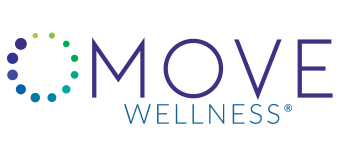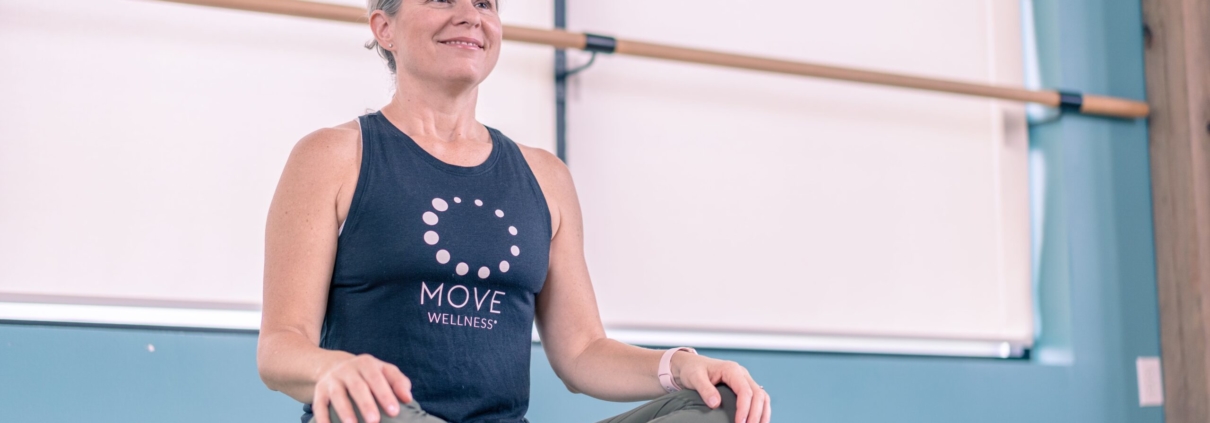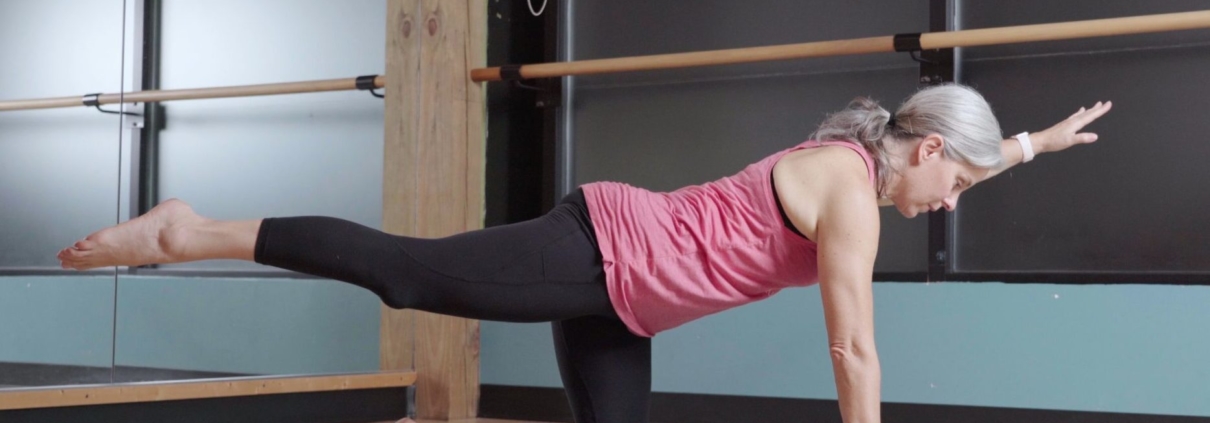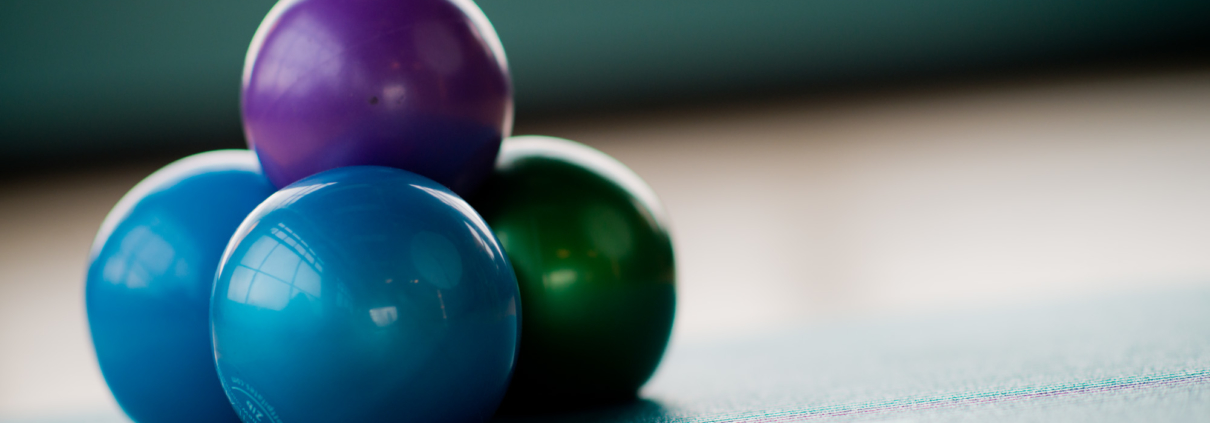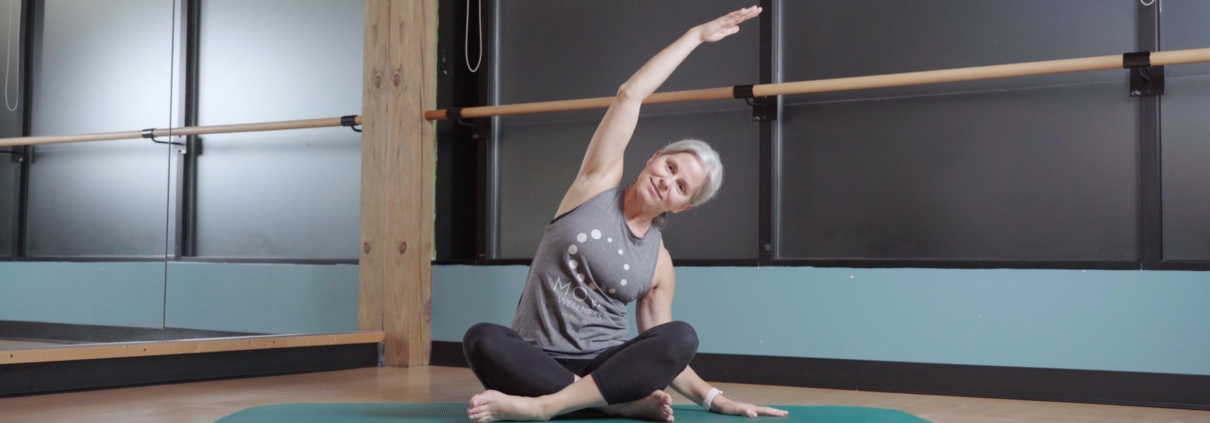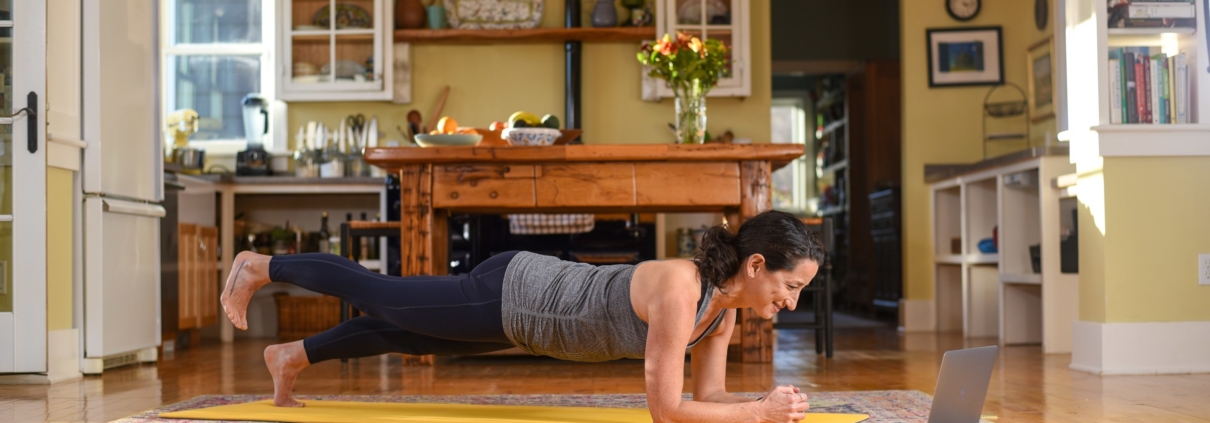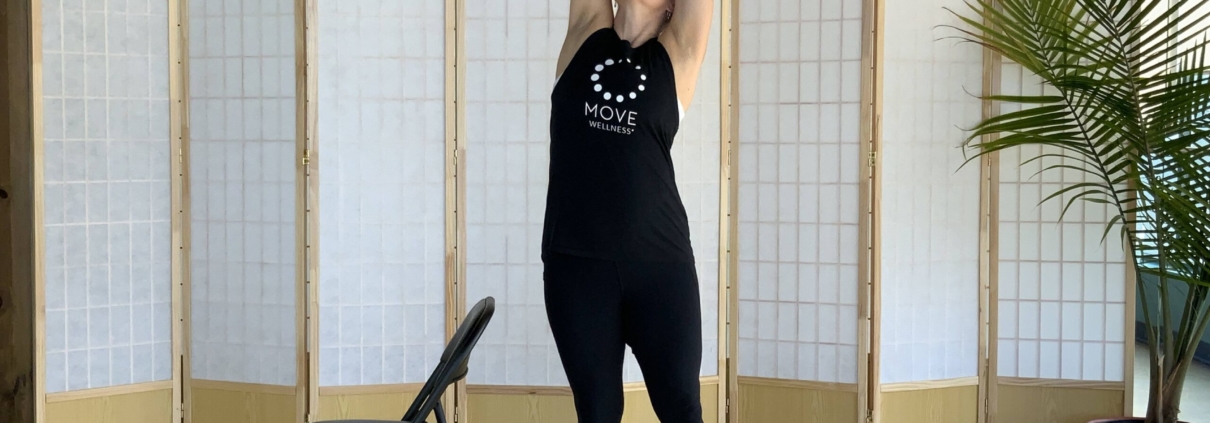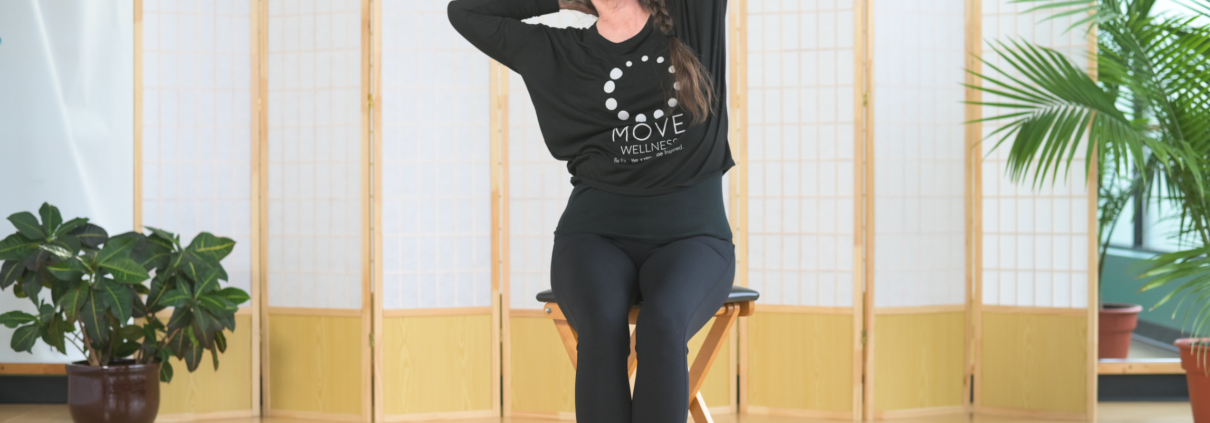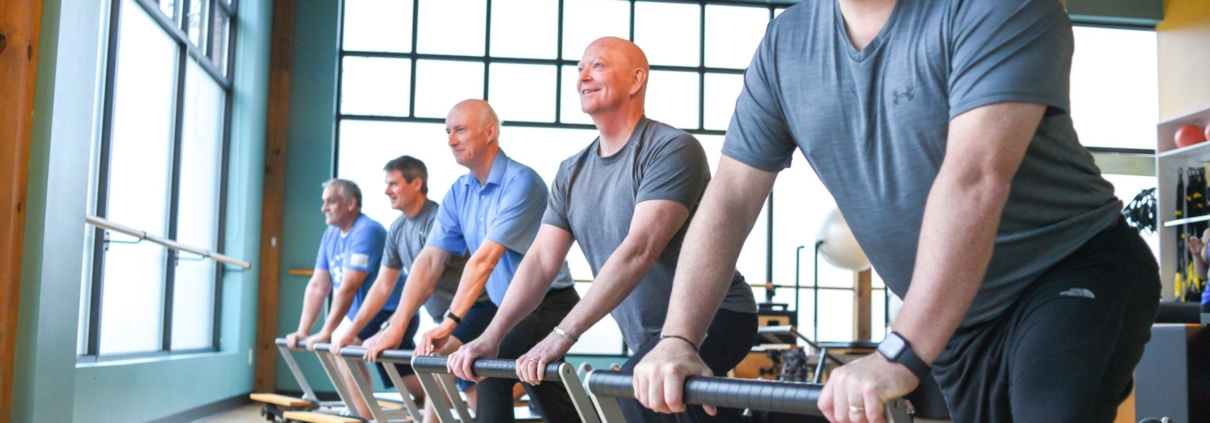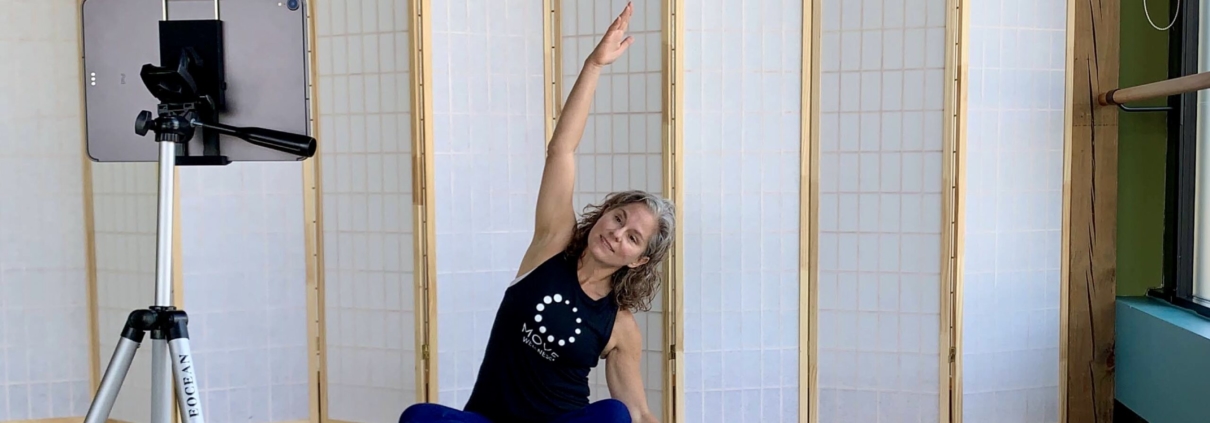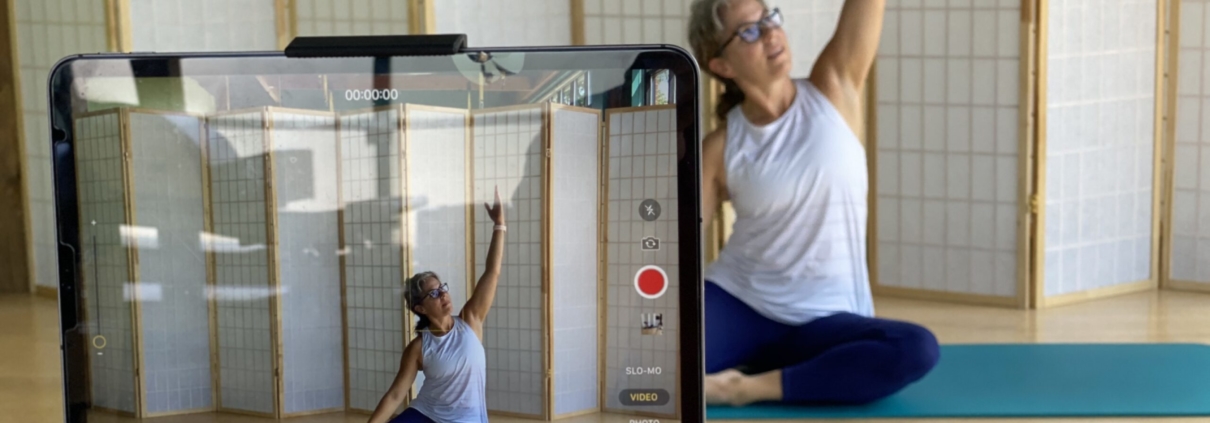“If you are just starting out or coming back to movement from a break or injury, low impact workouts are gentle on your joints. These types of workouts can ease you into the process of getting stronger, while giving your body a chance to build up the load tolerance on your tissues to avoid injury.”
—Elaine Economou
If you’ve made the decision to bring more movement into your life, congratulations! That commitment to yourself is the first step. And it’s a big one. Now it’s time to find the right workout.
Benefits of low impact workouts
Benefits of low-impact workouts include:
- Strengthening your body
- Improving flexibility
- Minimizing your risk of injury
- Helping you focus on the mind-body connection
- Improving your form and range of motion when working out
These benefits make low-impact workouts like Pilates a great choice for beginners or people who are returning to exercise after a break.
Elaine Economou‘s latest blog post for popular website Sixty and Me shares how a low impact workout can be a smart choice for beginners. Getting started with a mind-body movement system like Pilates can build strength and minimize your risk of injury.
Read the full blog post on Sixty and Me.
What is the best low impact workout?
The best low impact workout is the one you can commit to for at least a few minutes every day. Pilates is a great example. At MOVE Wellness we’ve seen its impact on clients again and again. Doing things you love regularly and getting outside to walk are also wonderful choices. As you build your commitment you can start increasing the pace and adding in workouts like the one I’ve provided below.
Can you lose weight with low impact exercise?
Low-impact workouts can support weight loss by helping you create a stronger, leaner body.
Low impact workout routine
Try this sequence of low impact movements perfect for beginners. You’ll be on your way to reaching your movement goals in no time!
Learn the essentials when you’re ready for more
Elaine Economou’s new Movement Essentials: Getting Started with Pilates is a 28-day program at MOVE On Demand designed to get you moving safely and keep you on track. Each week Elaine introduces you to the basic principles of Pilates with a consistent warm up, weekly classes, and a variety of special topics to enhance your journey. And, it comes with an easy-to-follow calendar that will guide you through a clear progression and provide a foundation for healthy movement.
Watch the trailer to learn more. Support the activities you love to do in life by starting today!
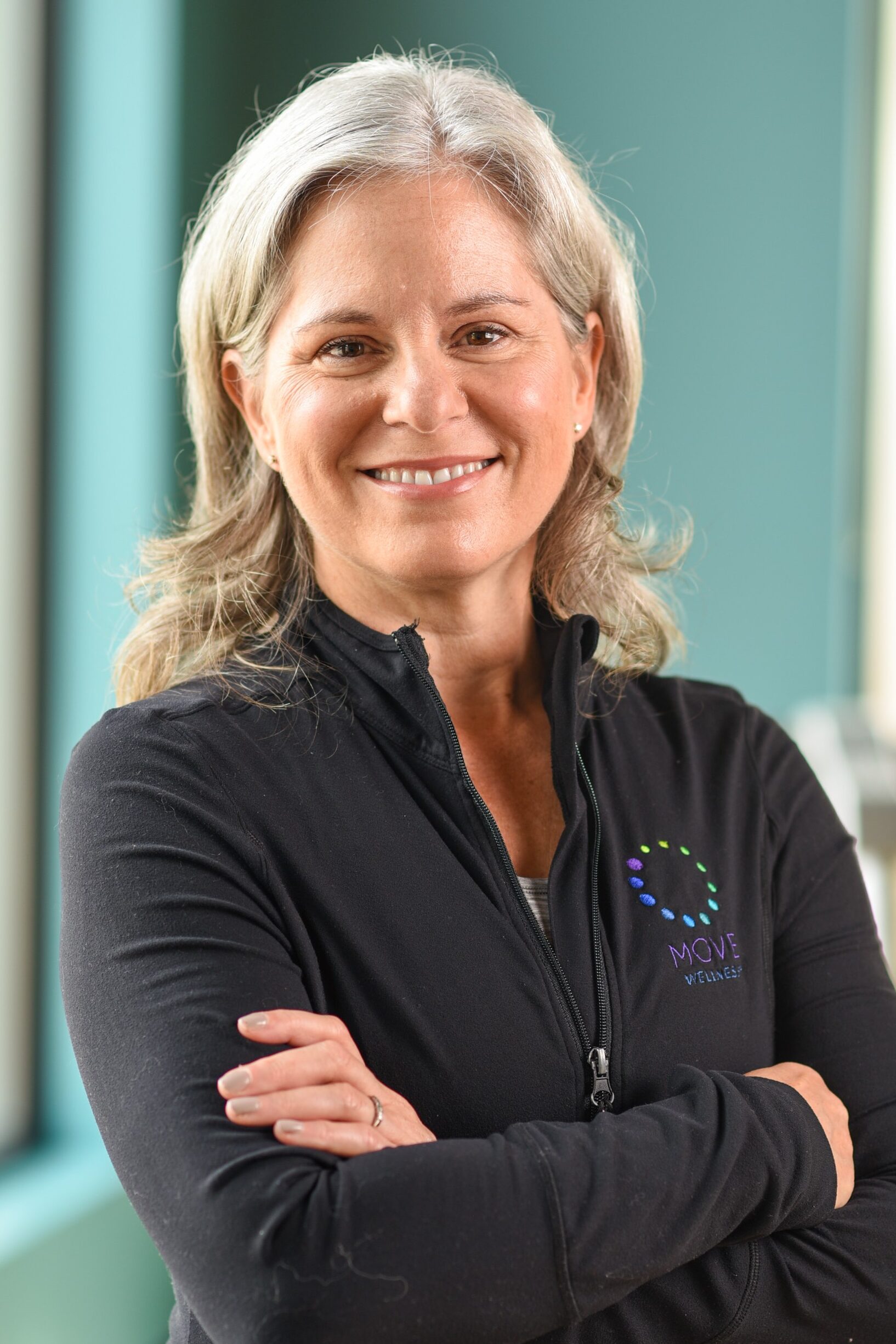
About Elaine Economou
As co-founder of MOVE Wellness®, Elaine Economou helps people move with ease, strength, and joy. Her passion is empowering people to understand their unique bodies and build strength to support moving well through their unique life. Elaine has created Movement Essentials: Getting Started with Pilates to help people move well and live a life they love – wherever and whenever.
Find all of Elaine’s Sixty and Me blogs on her author page.
How to Exercise to Prevent Injury
Finding a workout routine that you enjoy and can stick to is something to be celebrated. Moving consistently brings a sense of empowerment and accomplishment. And the more you move, the better you will feel. Still, it’s important to take into account any old injuries or discomfort in your body you may experience. At one point or another, many of us have felt nervous about injuring ourselves while exercising. Sometimes that fear of injury will cause enough worry to prevent you from increasing your challenge or trying something new that you might enjoy. Therefore, it’s essential to support your body’s unique needs throughout your routine to stay pain and injury free. Doing some little things on a regular basis can make a big difference. As we age, these little things become critical for maintaining our mobility and continuing to do what we love.
What are ways to prevent injury?
No one can wave a magic wand and prevent injury. But, we can make it far less likely by integrating these simple practices and injury prevention exercises into your daily routine.
#1: Practice noticing
First and foremost, practice noticing how your body feels. When you do Pilates, or any movement routine that connects breath to movement, you will begin to notice how your body feels when you move. Don’t ignore this. This mental “muscle”—the practice of noticing your body as you move—is your barometer, both while you are exercising and throughout all aspects of your day. When you pay attention to how you feel, if something doesn’t seem quite right you can make the decision to get curious and pay attention to the sensation or stop moving.
#2: Ask for help
Don’t work through pain and please seek support from a medical professional if you feel pain. The process of getting stronger will occasionally bring about some soreness. Increasing your routine and trying more challenging workouts may lead to those sensations. That’s a very normal part of training our body. Noticing the difference and knowing when to stop and seek help from a physician or physical therapist is key. Having a Pilates trainer help set up your workout or routine provides “eyes on your body”. That will help you create a program suited to your unique needs and prevent injury right from the start.
#3: Pace yourself
This is truly an instance of slow and steady winning the race. Make sure that you are trying more challenging routines or adding minutes to your workout a little at a time. Large jumps in intensity can lead to injury. Give your body time to adapt at its own pace.
#4: Build a foundation
Be sure to do some whole body movement like Pilates that will move your spine, shoulders and hips. These foundational movements will engage the core muscles to help keep the forces of whatever you do moving through your body in a balanced way. A key benefit of Pilates is that it focuses on individual postural issues and helps each person unravel their own unique muscular imbalances to create healthy movement patterns. Improved overall fitness levels may help prevent injury plus offer greater strength and ease of movement.
What exercise causes the most injury?
The simple answer: too much, too soon. Of any type of exercise. It often feels like we live in a culture of extreme fitness trends with the mantra go big or go home. Any workout your body is not prepared for is the one that brings the most risk. If you do something high impact or extremely cardiovascular without easing yourself into that activity, your body is going to be caught off guard. Anyone who has ever decided to take up running and thought they’d just head out and try to run a mile will know what I mean. By starting slowly, first walking, then jogging to start building endurance you’ll safely be able to progress to a running routine. Even in Pilates, if you once attended advanced classes but then took some time off, you’ll need to revisit the basics.
Jumping right back into complex movements without taking time to reinforce the foundational movements can leave you vulnerable to injury. Taking inspiration from a favorite silly board book about a bear hunt that I used to read to my kids, I like to say we have to go through the forest, not around, over or under it. The goal is to have you safely engage in movement in whatever range your body will allow, and then progress from there in ways that allow you to own that movement and experience joy and confidence in doing so.
How can I exercise without damaging my joints?
Exercises that move your spine in all of its planes of motion are important. Then, keeping hip joints mobile and having your legs and hips moving freely is important. This helps to keep the hips, core and back working together. It’s also important to make sure your abdominal and back muscles are engaging when they are needed. This will keep you from any strain in your trunk and support each movement. The nice thing about Pilates is that it’s easy on the joints. The mat exercises are low impact bodyweight training, so the forces on your bones will help you maintain bone density safely. There is so much you can do with just a mat and you.
Injury prevention exercises
In general, there are three characteristics of a successful home routine that I like to emphasize: consistency, progression, and balance. Moving your body every day in all planes of motion and through all the joints of the body will keep you strong and prepared for the type of unexpected movements that can cause injury. These exercises will mobilize the whole body, connect breath to movement, and are safe to do every day. You know what they say… an ounce of prevention is worth a pound of cure.
Arm Circles
Begin lying on your back with your knees bent and feet hip distance apart. Place your arms by your sides with your palms facing in towards the body. Take a nice inhale to lift your arms up toward the ceiling and then reach them overhead only as far as ribcage and shoulder stabilization can be maintained. Exhale to circle your arms wide out to sides and return down to your starting position. Repeat 4 times and switch directions for four circles.
Half Roll Back
Start seated on a mat with your feet flat on the floor, knees bent in front of you. Start upright in a neutral position with arms reaching in front of you parallel to the floor. While exhaling, start to roll your pelvis away from your femurs (legs) so that you feel your low abdominal muscles hugging into your spine. You are creating a “C” shape with your low back while keeping your shoulders wide and relaxed. Keep the “C” shape and inhale. Then, exhale to fold forward at the hips over your legs. Stack up your spine from tail to head and float your arms back to the starting position.
Hip Rolls
Start lying on your back with your knees bent and feet hip distance apart. Your arms are by your sides. Take a deep breath into the sides of your rib cage and feel yourself grow long through your spine. As you exhale, recruit your abdominals into an imprinted position by feeling your hip bones and ribs pull closer together until there is little or no gap between your spine and the floor. Once imprinted, articulate your spine starting from the tail to roll up into a bridge position where wide shoulders support your weight. Your hip joints are extended, and your knees should feel they are energetically reaching long over your toes. Take an inhale to stay here at the top, then roll down as you exhale to return to your starting position. Imagine your sit bones reaching toward your heels as you articulate down through your spine. Repeat eight times.
Mid-Back Spinal Rotation
Begin kneeling with elbows bent under shoulders and knees under hips. Your spine should be in a neutral position and feel as though it’s reaching long from tail to head. Your shoulder blades are stable against your rib cage. As you exhale, reach your elbow to the ceiling lead as you open your chest and allow your spine to rotate. Inhale to return to your starting position and repeat with your other arm. Repeat four times on each side.
Hip Circles
Begin kneeling on all fours with arms underneath shoulders, and knees directly underneath hips, slightly apart. Your spine should be reaching long from tail to head. Shift your weight to your right hand and knee and then circle your hips back to your heels on the right side then continue to shift your hips to the left side. Pull your pelvis underneath you as you continue the circle towards the starting position while arching your back like a cat. Feel that great cat stretch. You are making a circle with your spine first in extension and then flexion as you continue the movement. Do four to the right and then four to the left.
Bird-Dog Variation
Begin kneeling on all fours with arms underneath shoulders, and knees directly underneath hips, slightly apart. Your spine should be reaching long from tail to head. Inhale and find extra length through the spine. Exhale to recruit your abdominals and simultaneously lift your right arm and left leg, reaching towards opposite ends of the mat. Hold this balanced position as you inhale and reach fingertips and toes even longer. As you exhale, simultaneously lower your arm and leg to the starting position. Repeat on the other side. Be sure to keep your head level with your spine and keep length through the back of your neck.
Cat Stretch
Begin kneeling on all fours. Your arms should be underneath your shoulders and knees directly underneath the hips, slightly apart. Feel your spine reaching long from tail to head. Inhale to grow longer and find length through the spine. As you exhale, use your abdominals to round your spine like a Halloween cat. Start from your tailbone and leave the head for last. Hold this c-curve position while you inhale to breathe into the sides of your ribcage, rounding further. Finish with an exhale and beginning with the tail end of the spine, extend one vertebra at a time until you return to your starting position. Repeat six to eight times.
Squats
Stand tall with your feet wider than your hips. Propping your heels on a blanket or rolled up mat can be a helpful modification when you are just starting out with these deep squats (see video). Be sure your toes are pointed forward or slightly turned out and that your knees track over your feet. Your hands can hang by your sides. Bend at the knees and hips as though you are going to sit in a chair and go as far down as you can. Your weight will be in your heels. Keep your back straight and your gaze directed low in front of you. Pause at your lowest point for a moment then return to your starting position. Repeat four times.
Standing Side Arch
Stand with feet hip distance apart. Your weight should stay evenly distributed on both feet and your spine long and neutral. On an inhale, lift your arms over head while keeping your shoulders lengthened down. Grab your left wrist with your right hand overhead. As you exhale, lengthen your waist and spine and reach the heel of your hand away from the heel of your foot. Keep both sides of your body long and hips level. Be sure to stay square to the front and avoid rotating. Return to standing tall, switch the grip of your hands and repeat on the other side.
Move More, Feel Better
The price of a healthy body and personal wellness is hard to pinpoint because, in a way, health is defined by the absence of illness or injury. Sometimes we need a little guidance getting started in a safe way for our body. That’s why Elaine Economou created Movement Essentials: Getting Started with Pilates, a 28-day program at MOVE On Demand designed to get you moving safely and keep you on track. Each week Elaine introduces you to the basic principles of Pilates with a consistent warm up, weekly classes, and a variety of special topics to enhance your journey. And, it comes with an easy-to-follow calendar that will guide you through a clear progression and provide a foundation for healthy movement. Watch the trailer to learn more. Support the activities you love to do in life by starting today!
The 15 minute morning routine to improve mobility at any age
The latest blog from Elaine Economou is now posted on the popular website, Sixty and Me.
Moving in a thoughtful, balanced way on a daily basis has both short-term and long-term benefits for our health and wellness. Spending just 15 minutes each morning can help maintain our mobility as we age and continue to do what we love to do. Over time, a daily movement routine:
- Reduces inflammation and the achy joints that accompany it
- Stimulates our body’s systems and helps us feel more energized
- Encourages breathing and a mindful start to our day
- Creates balance by engaging our muscles
- Establishes a habit of moving more and sitting less
Read more and try this short head to toe routine to warm up all your joints. Doing little things consistently can make a big difference for your whole body and mobility. You can even do most of it before you get out of bed.
Check out this 15 minute mobility routine with Elaine on our YouTube channel. Watch HERE.
Move more, feel better
See for yourself what Pilates can do for you from the comfort of your own home. MOVE Wellness offers a free 14 day trial of our livestream classes with over 40 to choose from weekly. We are also welcoming clients safely into our Ann Arbor, MI studio for private training sessions. Whichever path is right for you, support the activities you love to do in life by starting your personal Pilates journey today!
About Elaine Economou
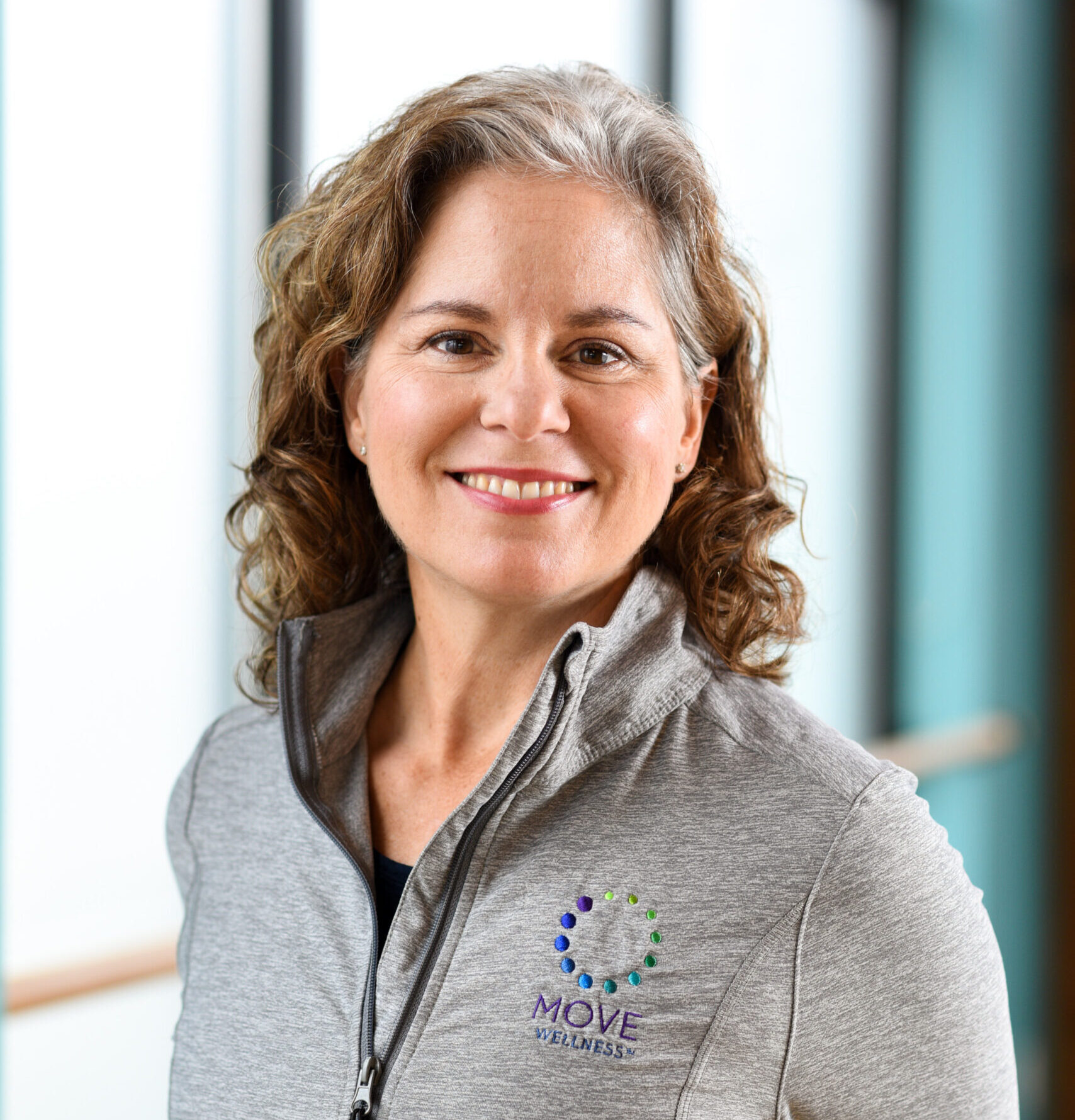
Elaine Economou helps people move with ease, strength, and joy. Her passion is empowering people to understand their unique bodies to build strength, and do more of what they love. As co-founder of MOVE Wellness®, Elaine leads a global movement community of clients in high-caliber, in-studio, and interactive livestream training.
Find all of Elaine’s Sixty and Me blogs on her author page.
Counteract the Effects of Sitting with these Simple Exercises for a Sedentary Lifestyle
The latest blog from our own Elaine Economou is now posted on the popular website, Sixty and Me.
“A majority of us have seen our routines and daily movement patterns uprooted over this last year by the global pandemic. Like it or not, we are spending a significant amount of time within the cozy confines of our own homes. Those of us working from home are commuting to a chair in the next room. Instead of walking across the office to ask a colleague a question, we are interacting on a screen. As we’ve all seen from mail and shipping delays, more of us are now doing our shopping and errands online. And let’s not forget all the happy hours or book group meetings moved to a Zoom format. What does this all add up to? We are moving our bodies less and sitting a lot more.”
Elaine Economou
The answer is to move more. With simple modifications to your daily routine, you can offset the effects of too much sitting in your lifestyle. Try the 10-minute routine in the video above with 9 exercises perfect for maintaining movement throughout your spine. These exercises can be done all at once, or one or two throughout the day. Be sure to read the full blog over on Sixty and Me to learn even more strategies.
Read 9 Simple Exercises for a Sedentary Lifestyle.
You CAN Start Now
See for yourself what Pilates can do for you from the comfort of your own home. MOVE Wellness offers a free 14 day trial of our livestream classes with over 40 to choose from weekly. We are also welcoming clients safely into our Ann Arbor, MI studio for private training sessions. Whichever path is right for you, support the activities you love to do in life by starting your personal Pilates journey today!

About Elaine Economou
Elaine Economou helps people move with ease, strength, and joy. Her passion is empowering people to understand their unique bodies to build strength, and do more of what they love. As co-founder of MOVE Wellness®, Elaine leads a global movement community of clients in high-caliber, in-studio, and interactive livestream training.
Find all of Elaine’s Sixty and Me blogs on her author page.
An In-Depth Guide to Building Muscle After 50: Core Exercises for Men When You Can No Longer Workout the Way You Used To
Wait. I’m over 50? How did that happen?! Can this be right? Sigh, I think it is… A lot of us grew up on a football field, both playing and watching on Sunday nights. The baseball diamond was our favorite pastime, live or on the radio. TV’s Wide World of Sports gave us the thrill of victory and the agony of defeat. Those were all mountains we could climb and conquer effortlessly, but now some of these challenges are chillingly reminiscent of that skier wiping out on national TV.
Rumination on Fitness After 50
As we get older we can be more prone to injury, which can slow if not derail an exercise program. Approaching exercise as if we were still suiting up for the Friday night game of our youth can often result in painful and sometimes dangerous injuries. Whether in the weight room or the crossfit class, overtraining may lead to (*ahem, middle-aged) types of injuries. Rotator cuffs, torn meniscuses, and plantar fasciitis to name a few, can range from disruptions to unemployment.
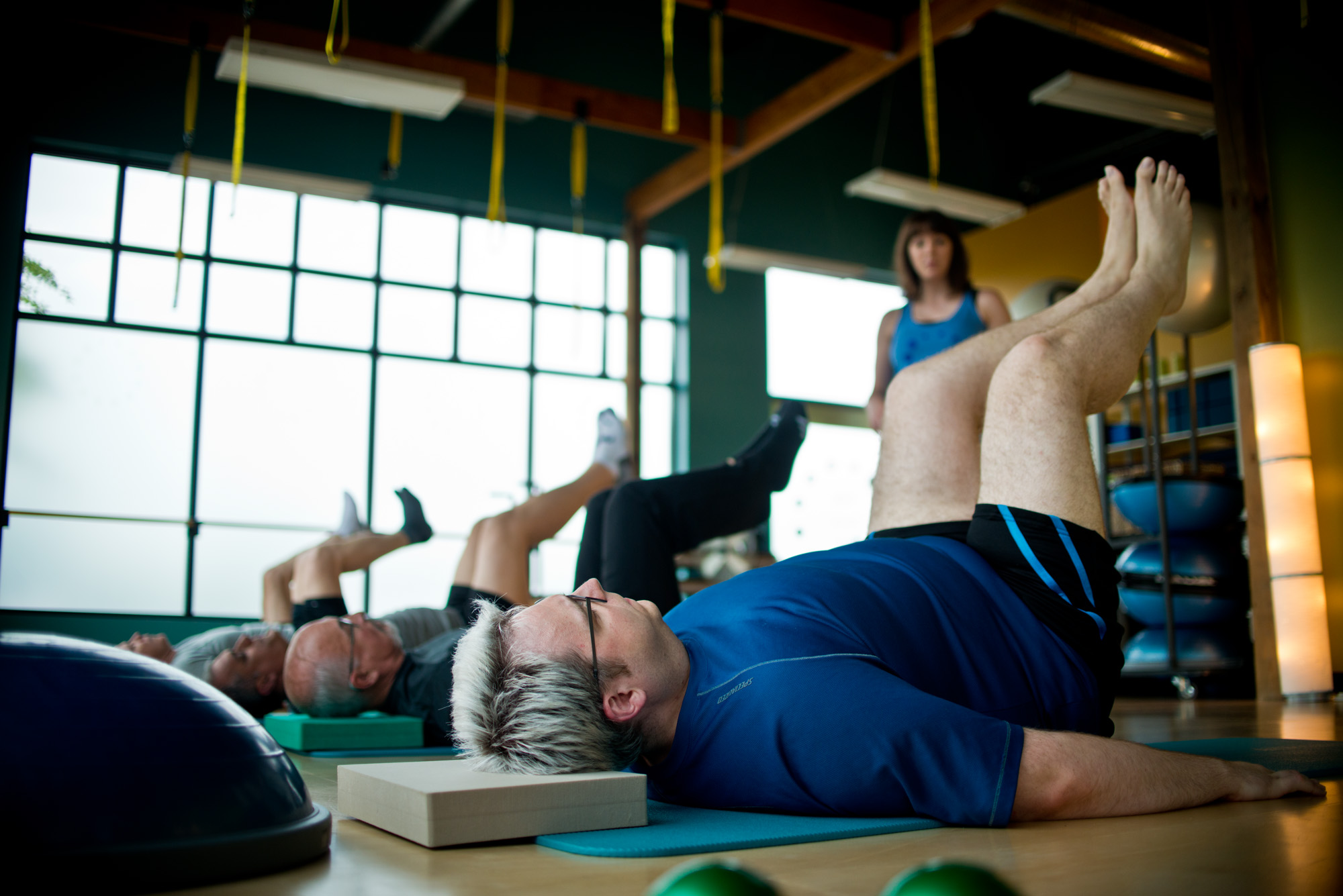
As we age it is also more difficult to build muscle. (Sadly, it seems super easy to gain fat, though, which is totally unfair.) In order to combat both negatives, movement remains the key, but careful self-assessment and exercising in smarter ways are in order. We may have to shift away from higher impact exercise to more consistent, gentler forms like walking or swimming. While healthy, some men find that this adjustment is tough on the mind because it becomes an admission of aging. Fortunately, just because we cannot workout like we used to, it does not follow that we cannot strengthen and condition the body after 50. Starting with core training, or strengthening the muscles of the abdomen, spine and pelvis is a great way to ensure that you get fit safely.
How do I strengthen my core?
Our core really is the central command in our body. Working from the inside out, all the movements we do in exercise and daily life have a foundation in our core. Motion either begins in, or moves through our core. Keeping that foundation strong ensures that as we move through life, everything outward will be supported. There are both fitness and real-life benefits to keeping our core strong. Think about all the times in your day you reach, turn, bend, or lift something. Your core is the not-so-secret helper supporting all of that movement. Whether you’re sitting at a desk, putting away groceries, playing golf with friends, or taking a hike in the woods your body needs stability and mobility. Like most things in the fitness world, there’s more than one way to reach our goals. The best movement is the one that you’ll actually stick with and enjoy!
What’s the best core workout?
So what’s the best way to keep our core strong and working hard for us? A classic Google search mostly reveals top-ten type lists of specific exercises we can do.
The most common core exercises for men include:
- Planks
- Bridges
- Crunches
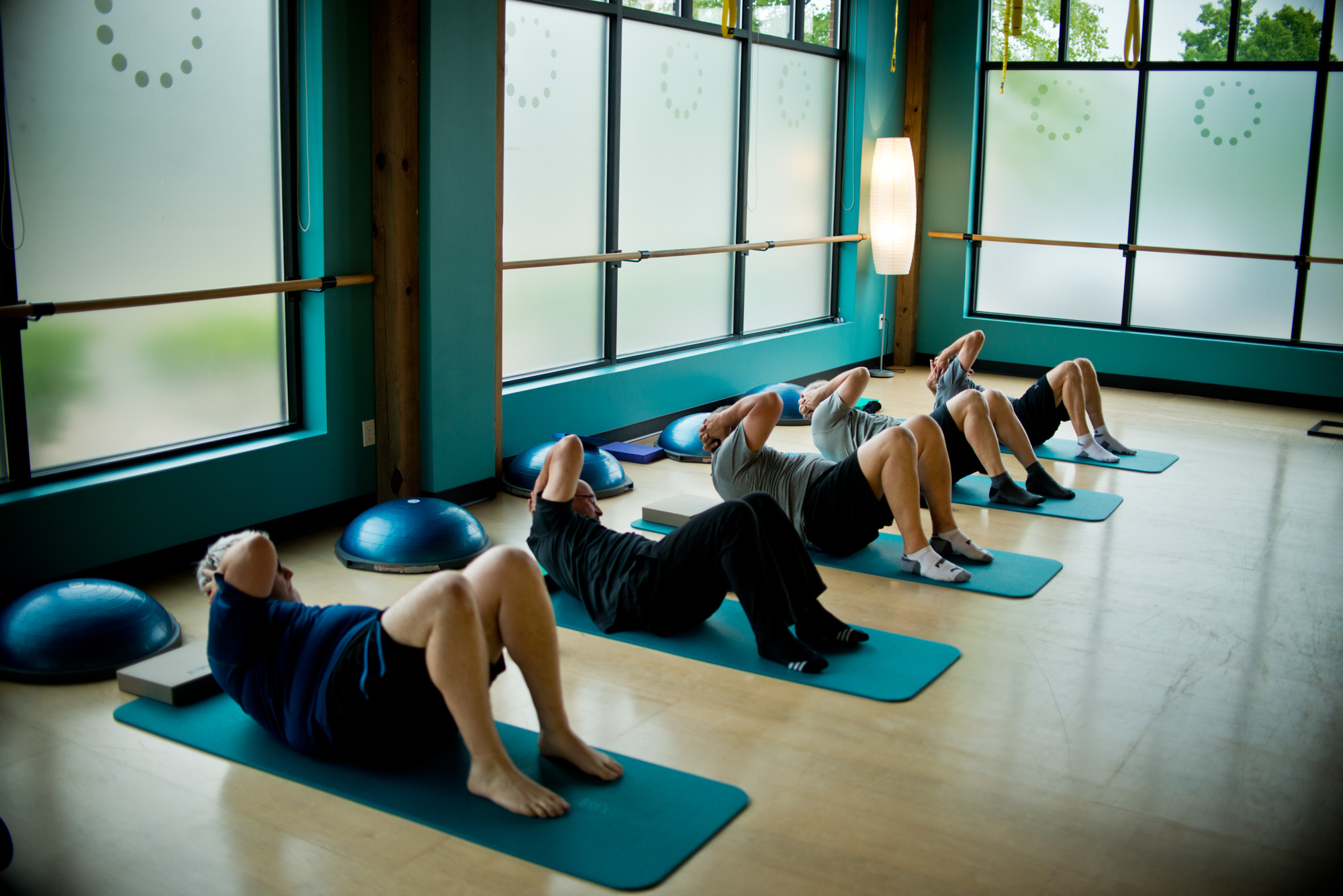
Some great studio or gym-based workouts with core strengthening benefits include:
- Yoga
- Kickboxing
- Cycling
- Pilates
- GYROTONIC®
In particular though, let’s talk about these last two types of strengthening and conditioning systems on this list that, while not new, are newer to men. Pilates and GYROTONIC® are growing in popularity among men of all ages who want to build muscle and strengthen their core. These exercise systems offer improved balance, sure-footedness, reduced back pain, greater flexibility, and so much more.
These workouts support other fun activities, add to our quality of life, and keep us moving pain free. Other activities that complement these workouts include:
- Golf
- Dancing
- Tennis
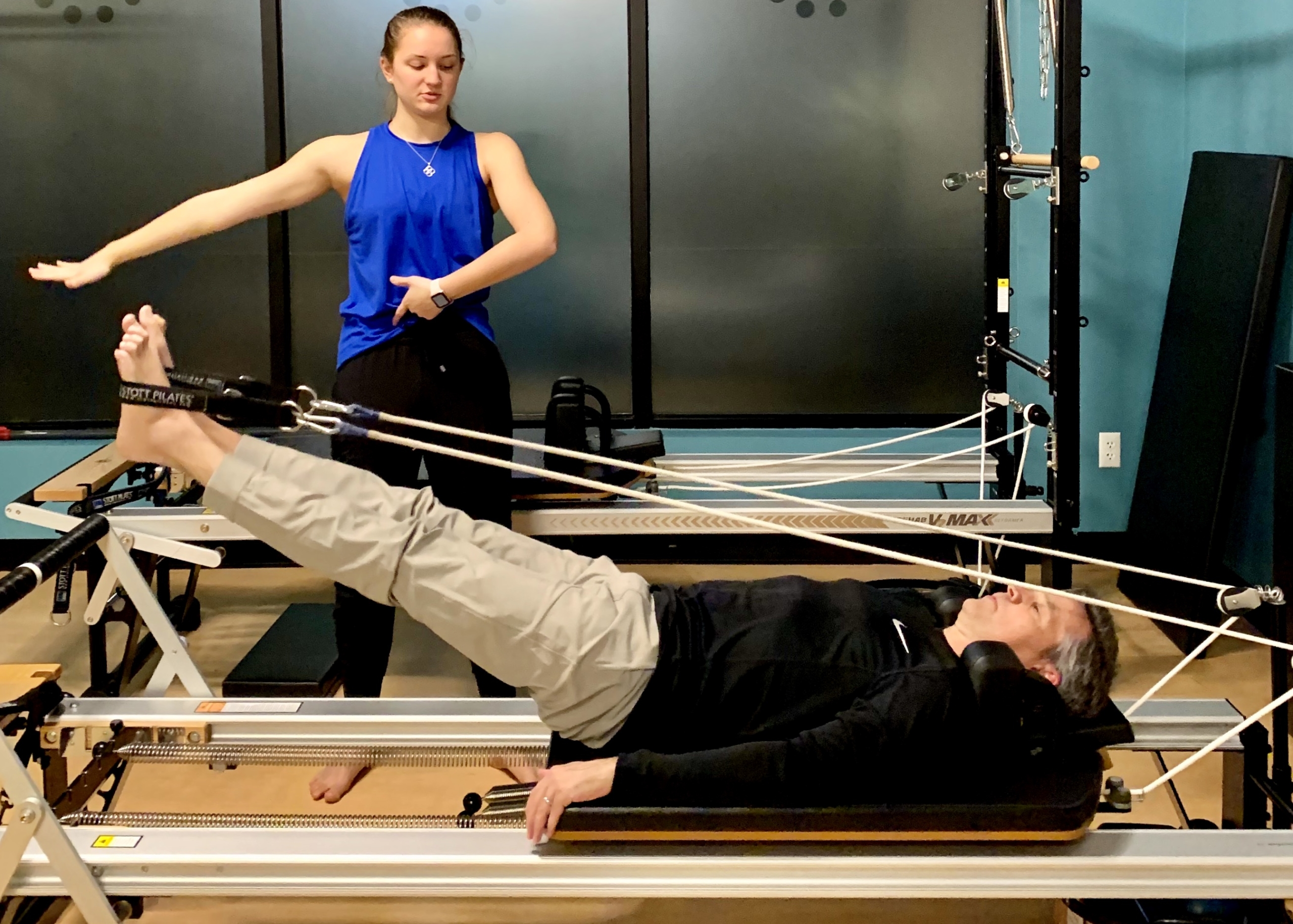
Pilates
Pilates was created by Joseph Pilates starting as early as the 1920s. His thinking about fitness began with how to help injured soldiers and was also influenced by ancient statues of Gods and their musculature. He even studied the movements of animals in designing his exercises.
Pilates is a system designed to help you strengthen and mobilize your body. There are a variety of exercises that target strength and mobility for the whole body, always initiating with the core. They can be done on a mat or unique equipment strategically designed to allow for the fullest expression of movement. Some pieces of equipment you would likely find in your session include the Reformer, Cadillac, chair, and barrel.
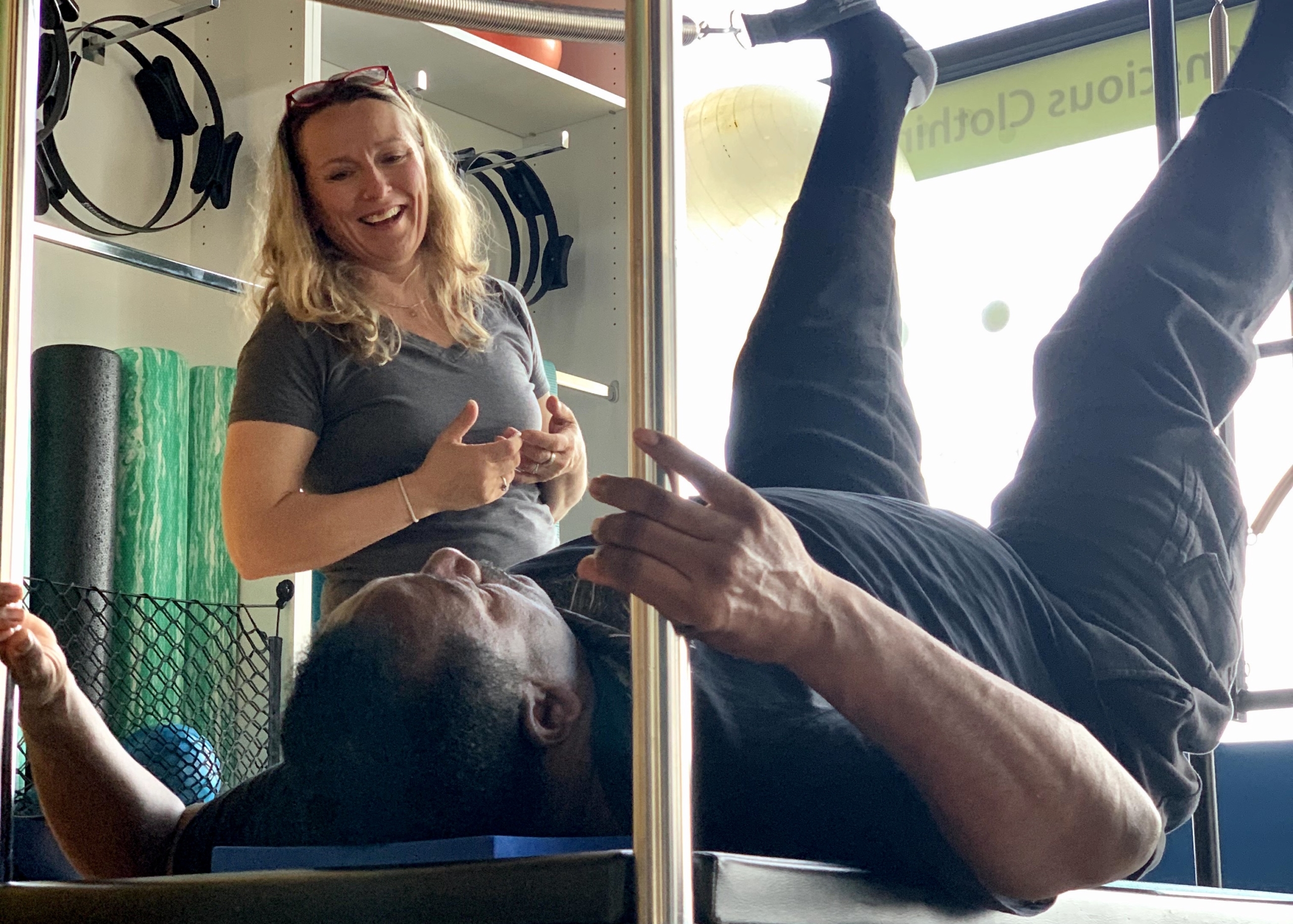
In any session, including an introductory session, the trainer will aim to move you through all possible planes of movement of the spine if possible. Your session will include exercises that move the spine forward and back, sideways, and rotating into a spiral. You will also be taught to stabilize your spine and pelvis using your core.
This innovative mind-body system of exercise continues to grow in popularity. Pilates is practiced by many professional athletes from a variety of sports, including Lebron James, Jake Arrieta, Martellus Bennett, and Auston Matthews to name a few. Pilates is also a safe and effective program that can be used to great effect by men over 50 to support fitness routines and recreation. Whatever your conditioning goal, Pilates is an efficient, effective, and safe way to increase your mobility, strengthen, develop your core, and release tension.
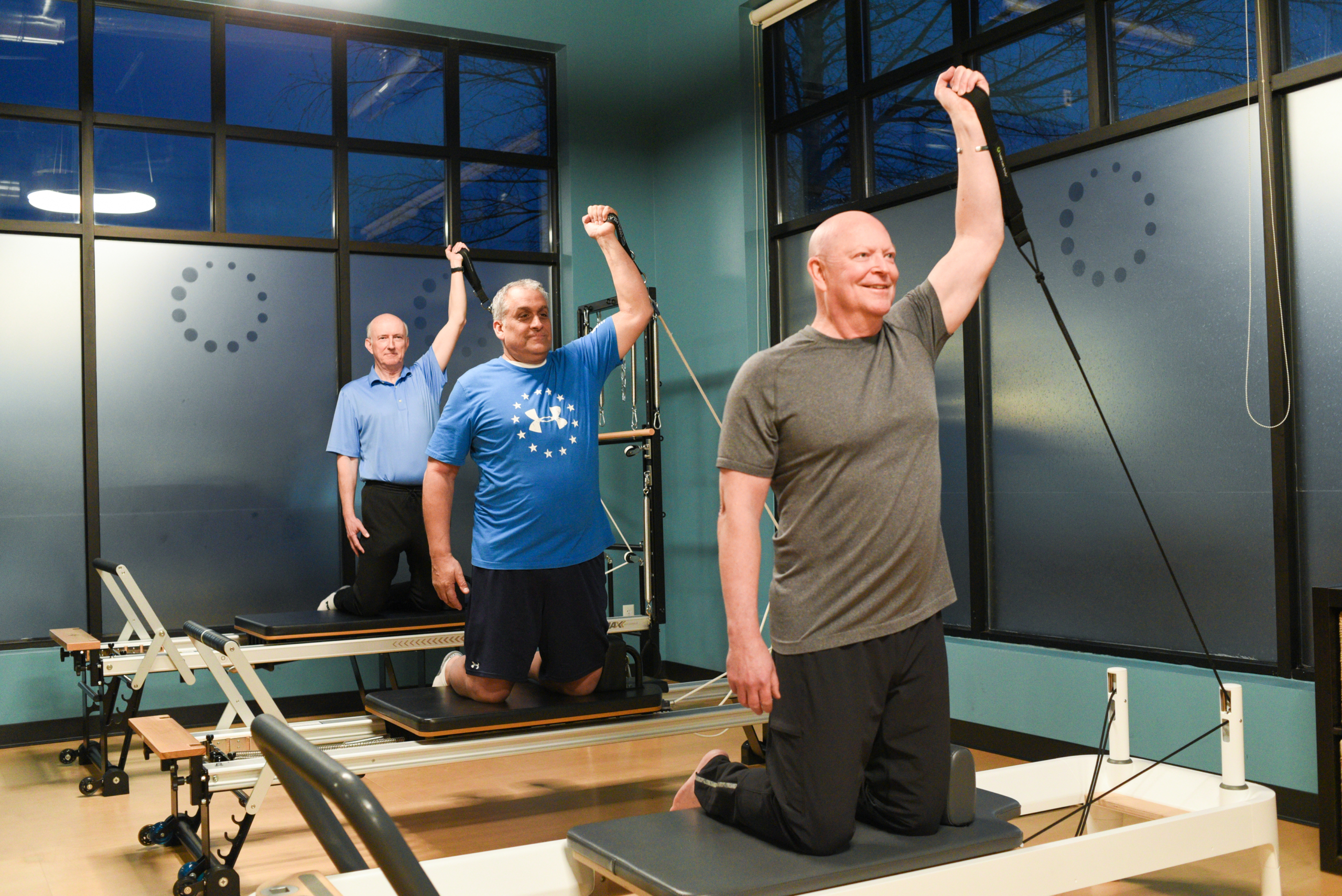
Benefits of Pilates for Men
We can’t all be Lebron James (and I can assure you that I am not) when we head out to play basketball, but we can all experience the benefits of Pilates for men. My personal experience with Pilates is that it is a challenging workout that focuses on building core strength and overall strength and mobility in the body. It really hones in on what some guys my age are going through and supports our other active life pursuits. In addition to the muscle strengthening of a session, it also focuses on creating and improving flexibility and balance. These are not easy workouts. The focus and control you need to practice the exercises makes this system unique and efficient. Other benefits of Pilates include injury prevention and recovery (and not injury production).
Best Pilates Exercises for Strengthening Your Core
A great place to start? Follow along with this simple 15-minute Men’s Core Session video. It doesn’t take long to get that core active and working hard! This workout is a great way to start your day or unwind in the evening.
Or, here are a few of our favorite Pilates core exercises for men to get you started at home. Try adding them to your regular workout routines.
The Hundred
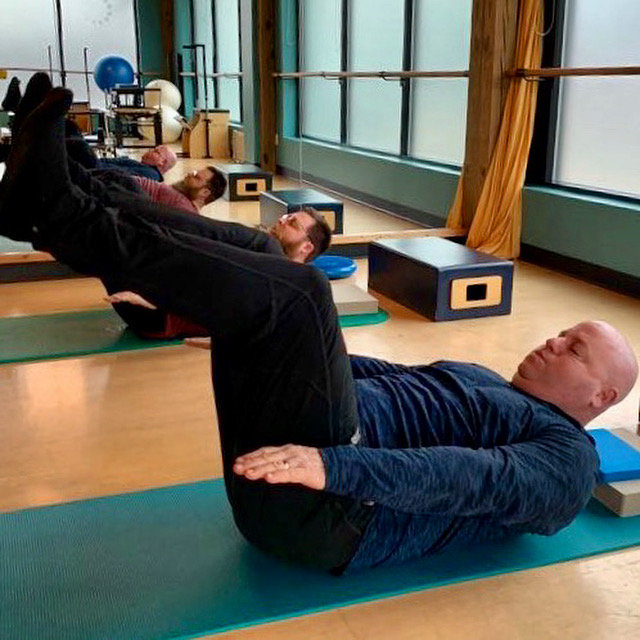
- Start lying on a firm surface, legs together knees bent, feet flat.
- Inhale to prepare, exhale to deepen abdominals to imprint and lift legs, either together, or one at a time to tabletop.
- Inhale to lengthen the back of neck and nod chin gently. Exhale flex up through upper thoracic, keeping lower tips of scapulae on floor, extend legs to straight (or when just starting out, keep knees bent or on the floor).
- Begin pulsing the arms. Inhale for five counts and five pulses of the arms. Exhale for five counts and five pulses of the arms. Repeat 10 times for a total of 100 pulses
- One last inhale to stay lifted as legs fold into tabletop and exhale to lower down of upper body in a controlled way.
Single-Leg Stretch
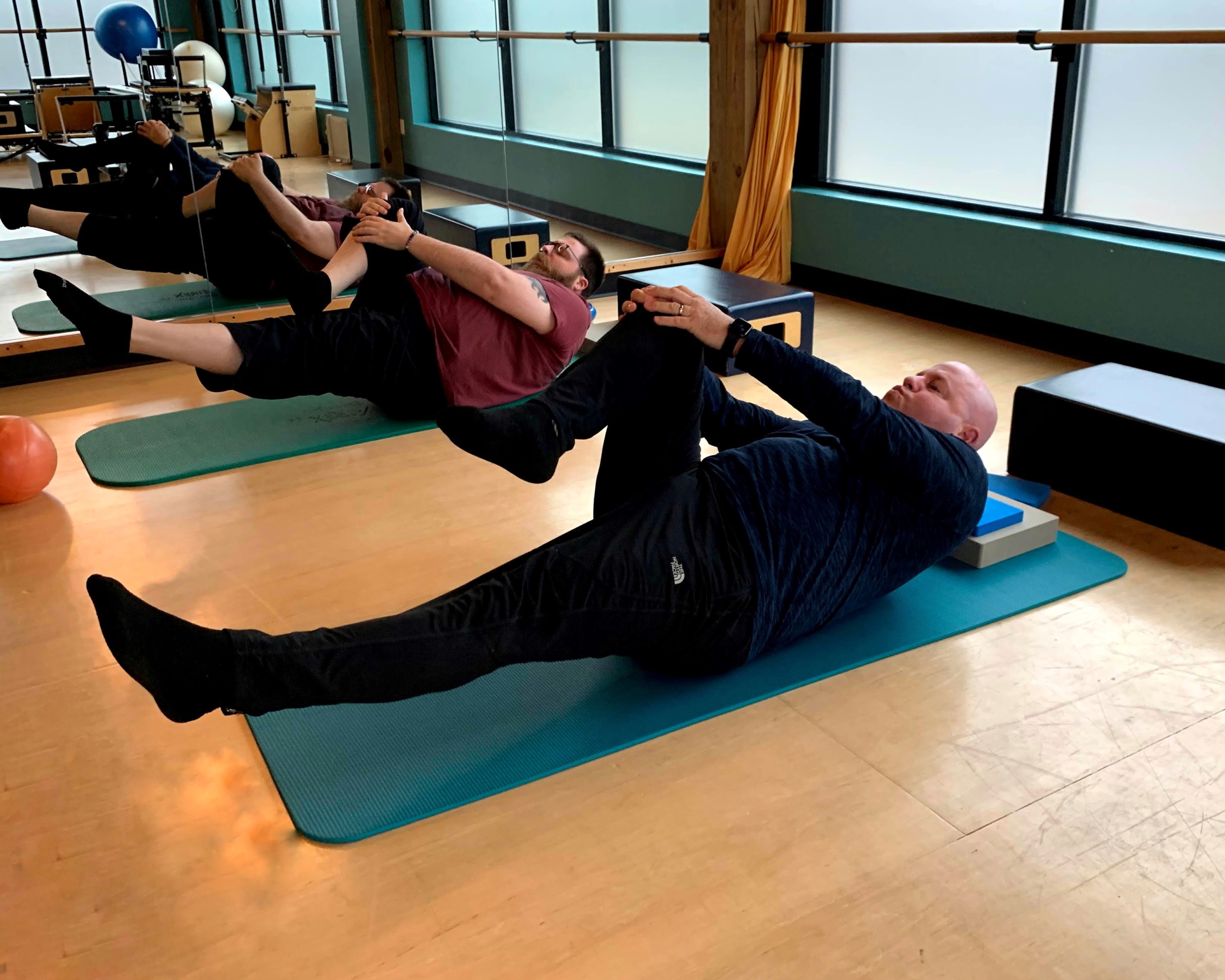
- Start lying on a firm surface, legs together knees bent, feet flat on the floor.
- Inhale to prepare, exhale to deepen abdominals to imprint and lift legs, either together, or one at a time to tabletop.
- Inhale to lengthen the back of neck and nod chin gently. Exhale flex up through upper thoracic, keeping lower tips of scapulae on floor, hands reaching by knees. Inhale to stay.
- Exhale to extend one leg to straight, tapping hands to sides of bent knee or, for a challenge, outside hand to ankle, inside hand to knee.
- Inhale to begin exchange of legs, and exhale to extend the other leg.
- Repeat 6-10 times on each side.
- Inhale to fold legs to tabletop and exhale to lower down with control.
Side Leg Kick
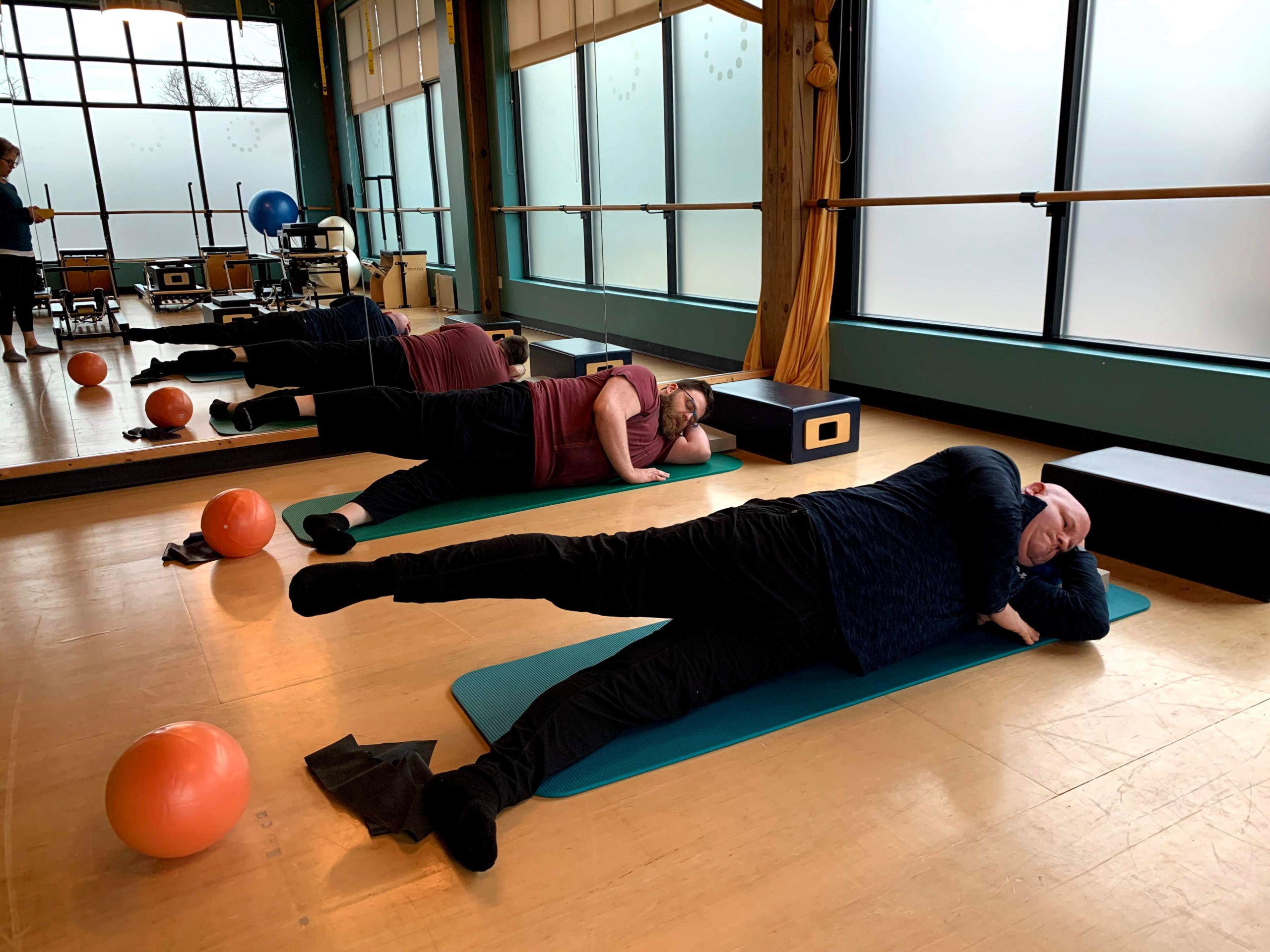
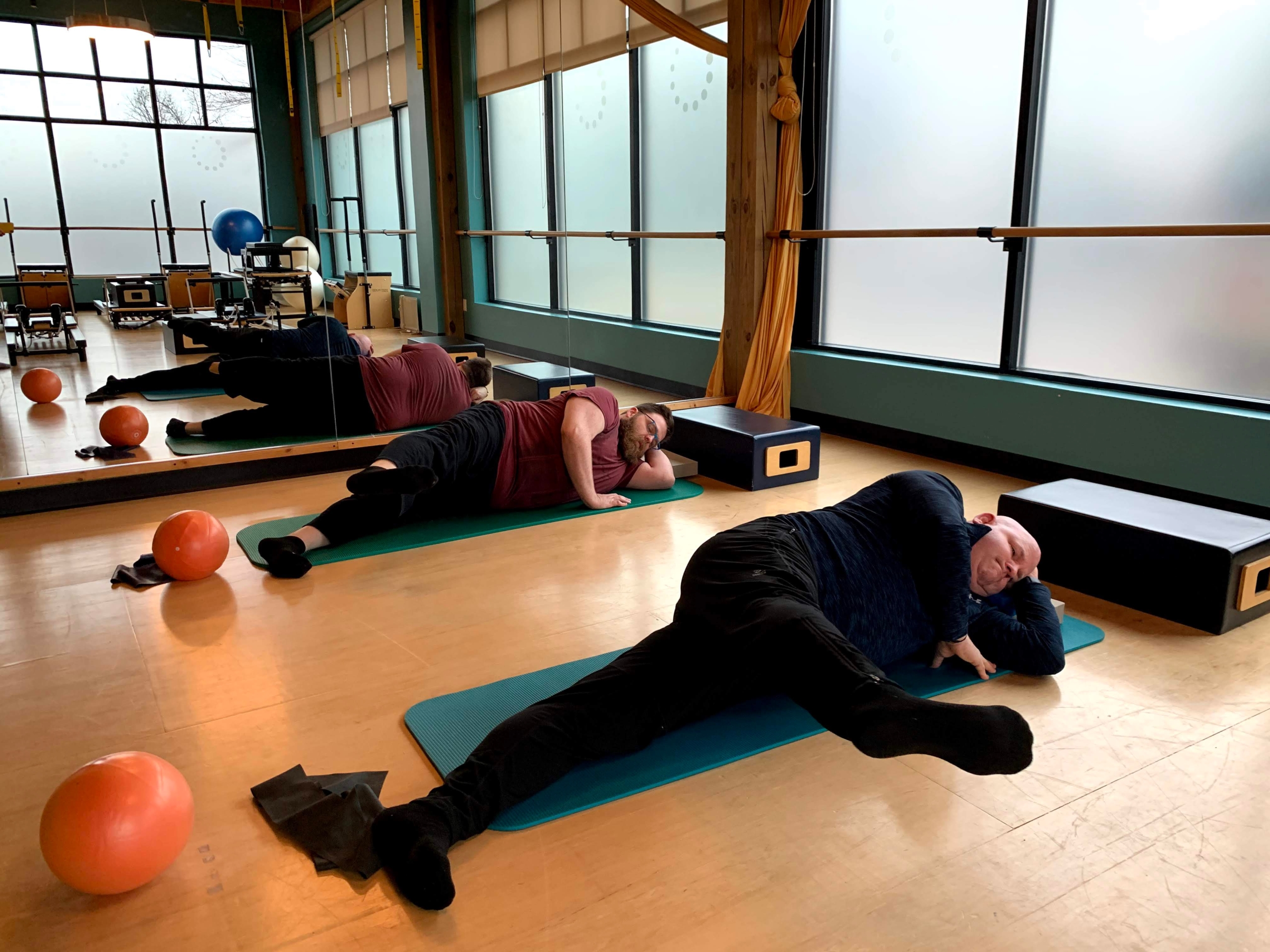
- Start lying on side with spine long, legs straight at an angle slightly forward of the torso, top leg at hip level. Bottom leg can be bent if needed for balance. Head can either rest on hand, or arm can be long or folded on the floor to make a support for the head.
- Inhale to sweep the top leg forward with foot flexed for two gentle pulses, only as far as neutral spine can be maintained.
- Exhale to point foot and sweep leg to back for one long reach, maintaining neutral spine.
- Keep hips stacked straight and not allowed to roll forward or back.
- Don’t allow the rib cage to pop forward, especially when the leg goes back.
- Complete 8-10 repetitions and then repeat on the other side.
GYROTONIC® Exercise
Another great option for core exercises for men is GYROTONIC® Exercise. This is a less well known type of workout, not having the current popular reach of Pilates. It is nonetheless an up and coming program worth trying that offers up movement fusion of yoga, ballet, tai chi, gymnastics, and swimming.
The GYROTONIC EXPANSION SYSTEM® method was created by Juliu Horvath beginning about 40 years ago. While it may sound foreign to those that grew up on a weight bench, GYROTONIC® exercise allows users to stretch and strengthen muscles, while simultaneously stimulating and strengthening connective tissues in and around the joints of the body for full body benefit. The exercises involve a series of circular and fluid movements on weight and pulley-based machines coordinated with breathing patterns to support aerobic and cardiovascular health. All this in one workout package. What’s not to like?
Benefits of GYROTONIC® Exercise for Men
In 2016, British tennis great Andy Murray credited GYROTONIC® exercise with helping him back to Wimbledon after his back surgery. For the rest of us, we can access a long list of benefits for daily life including:
- Strong, lean muscles.
- Increased flexibility, coordination, and balance.
- Enhanced joint mobility and articulation.
- Ease of movement.
- Increased circulation of blood, lymphatic fluids, and energy.
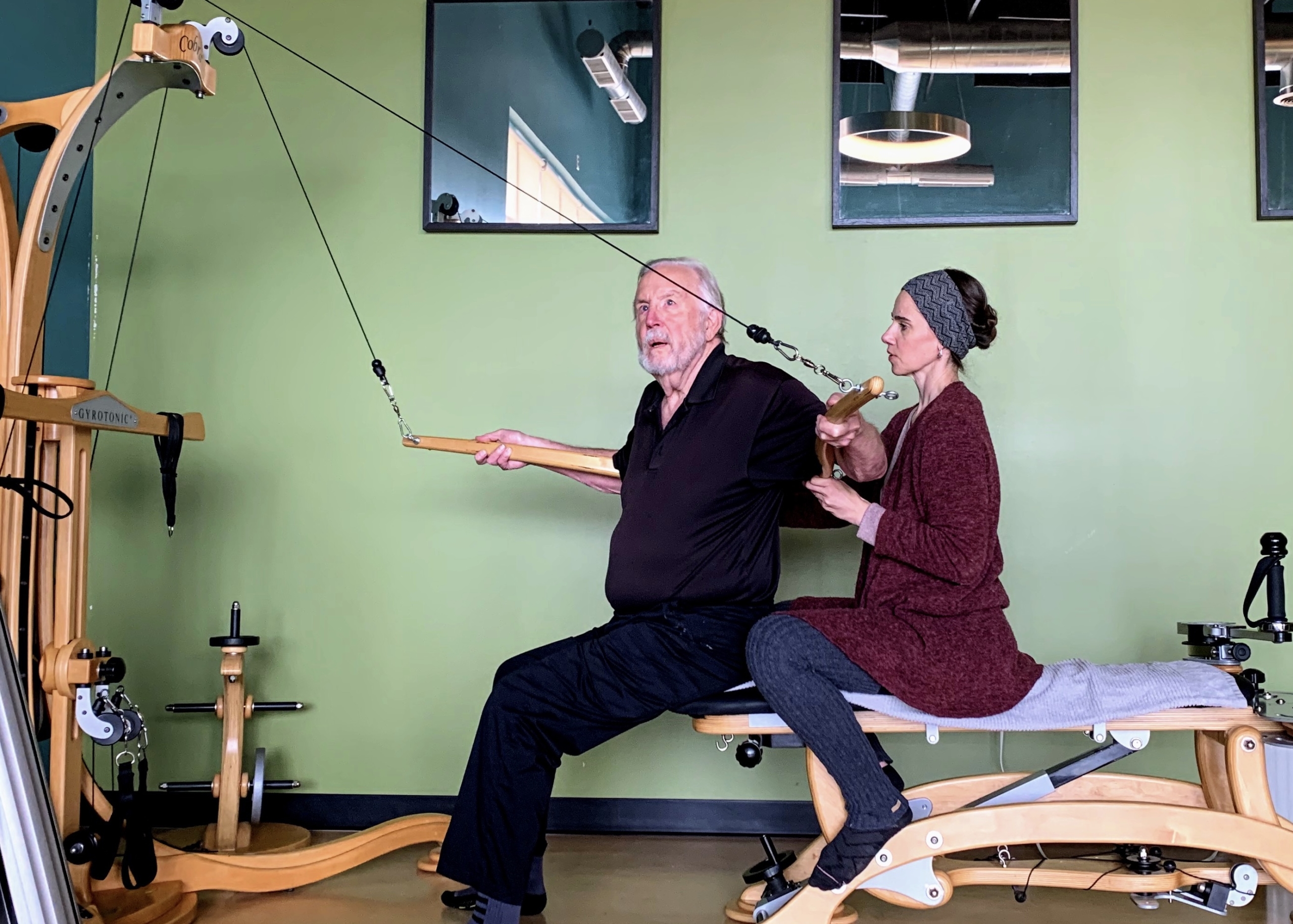
In addition, GYROTONIC® Exercise:
- Complements/supplements physical therapy and other rehabilitative bodywork.
- Helps slow the aging process through mental and physical stimulation and regeneration.
- Relieves low back pain and the postural effects of sitting.
- Improves mind-body focus, concentration and coordination.
GYROTONIC® training is also beneficial to men of a “certain” age, as it relates to building strength, balance, and flexibility while preventing injury and supporting life’s activities. For me, GYROTONIC® exercise just feels good. That doesn’t mean it’s easy, I feel like the spiraling movements strengthen my whole body instead of one muscle group at a time. That is different than what I have been used to in the gym. I do it weekly and during periods of time when I can’t, I definitely feel worse for the wear.
Strengthening Your Core After 50
I’ve been doing both Pilates and GYROTONIC® exercise for 5 years now. While I am still an amateur and still appear that way on the equipment, I can say that they have both improved my quality of movement and life. I simply feel better when I am exercising in these ways. Whether you are a lumberjack or a desk jockey, you will notice how these methods bring daily improvement.
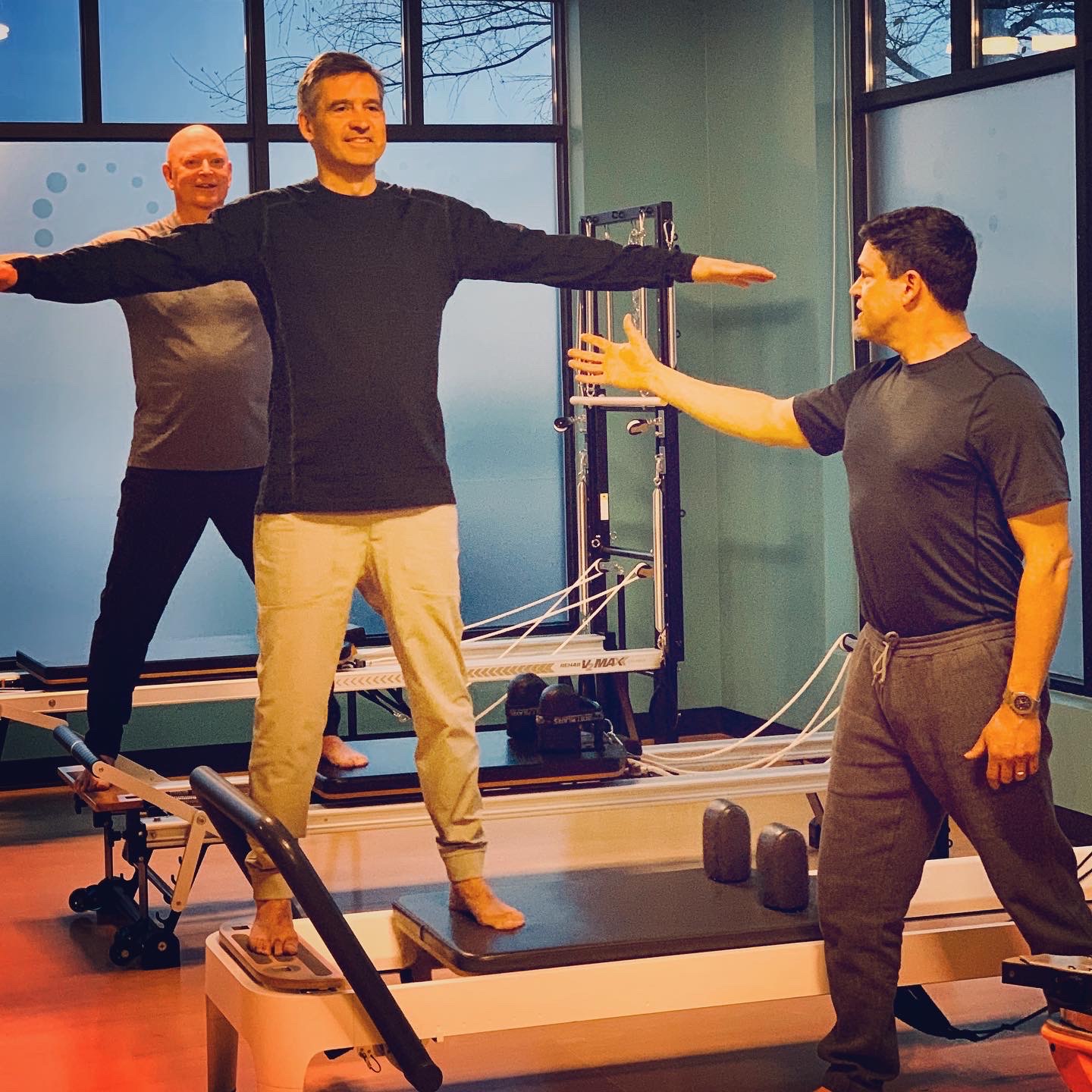
You Can Start Now
Pilates and GYROTONIC® exercise are both effective functional training methods to support your life’s activities as you celebrate more birthdays. MOVE Wellness has experienced trainers who can help you workout safely and effectively and provide accommodation for any injuries or nagging pains. Talk to your trainer about your personal goals for the movement that matters in your life so we can support you in achieving those goals. MOVE offers private training in-person or online as well as MOVE Livestream with interactive livestream group classes you can take from the comfort and privacy of your own home. In addition, MOVE On Demand offers programs and classes you can access whenever and wherever you want.
Call us today at 734-224-2560 to learn more or start now online to schedule in-studio. We also have a 14 day free trial of MOVE Livestream classes you can take advantage of.
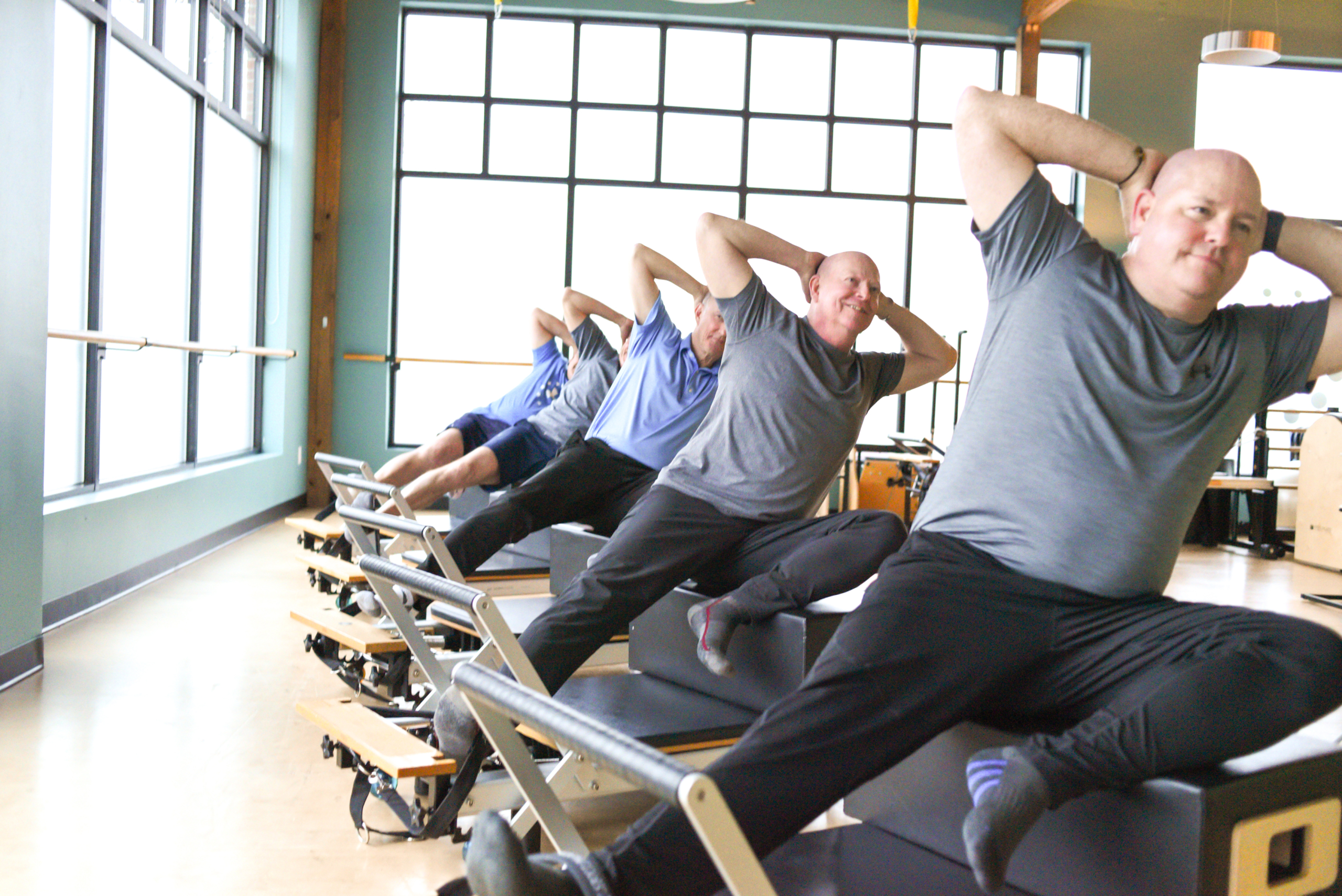
About the Author: Patrick J. Conlin Jr.
Patrick Conlin was raised in the Ann Arbor area and is a Circuit Court Judge in Washtenaw County. Patrick is the guy you can all relate to reading this blog. He’s reached that over-50 stage in life where he can’t work out the way he used to, but knows firsthand how important movement is and has 3 sons to keep up with. Spoiler alert…If you didn’t already know, Patrick is also MOVE co-founder Elaine Economou’s husband. He has been doing PIlates for more than 20 years. Basically, as long as he’s known Elaine. He added Gyrotonic to his workout mix around the time MOVE Wellness opened 6 years ago. Patrick knows the value of exercise and the powerful impact it has on his life and longevity.
Why Try MOVE Livestream Classes
Whether you’re local to Ann Arbor or across the country, you can now join our high-quality, interactive livestream classes from the comfort of your home. Livestream classes offer new content each session with the energy of a live instructor to motivate and guide you in real time. You’ll have access to our expert team to answer your personal questions—something you won’t find with pre-recorded workouts. Choose from Pilates, GYROKINESIS®, Barre, Yoga, HIIT, and more. Our weekly class schedule includes over 30 classes. All you need is a device for streaming and space to move. Find frequently asked questions about livestream classes at MOVE here.
But really, we know there’s free content all over the internet. We also know you can subscribe to some really big brands for a lot less. So what sets our program apart and why are we worth a look? Why are 30 LIVE classes better than 3000 on demand classes? Here are 7 reasons to choose MOVE livestream. But don’t just take our word for it, give us a try and see for yourself with our 14-day free trial.

- Built-in accountability when you register for a live class
Admit it. There’s just something special about scheduling something and putting it in your calendar that makes you more likely to follow through. It’s so easy to get caught up in our busy schedules and “forget” to make time for ourselves. But if you’ve signed up for a class with a live instructor, you’re much more likely to make the time and hold yourself accountable. The sense of commitment increases when we find a class we love and incorporate it into our weekly routine.

- Motivating energy of live instruction to keep you moving
We’ve done plenty of pre-recorded workouts. There’s lots of enthusiasm, but not much spontaneity. An instructor truly enjoying teaching clients in realtime and the ability to adapt the pace or content of a class based on the participants’ needs is irreplaceable. It feels like we’re all a part of one community moving together.
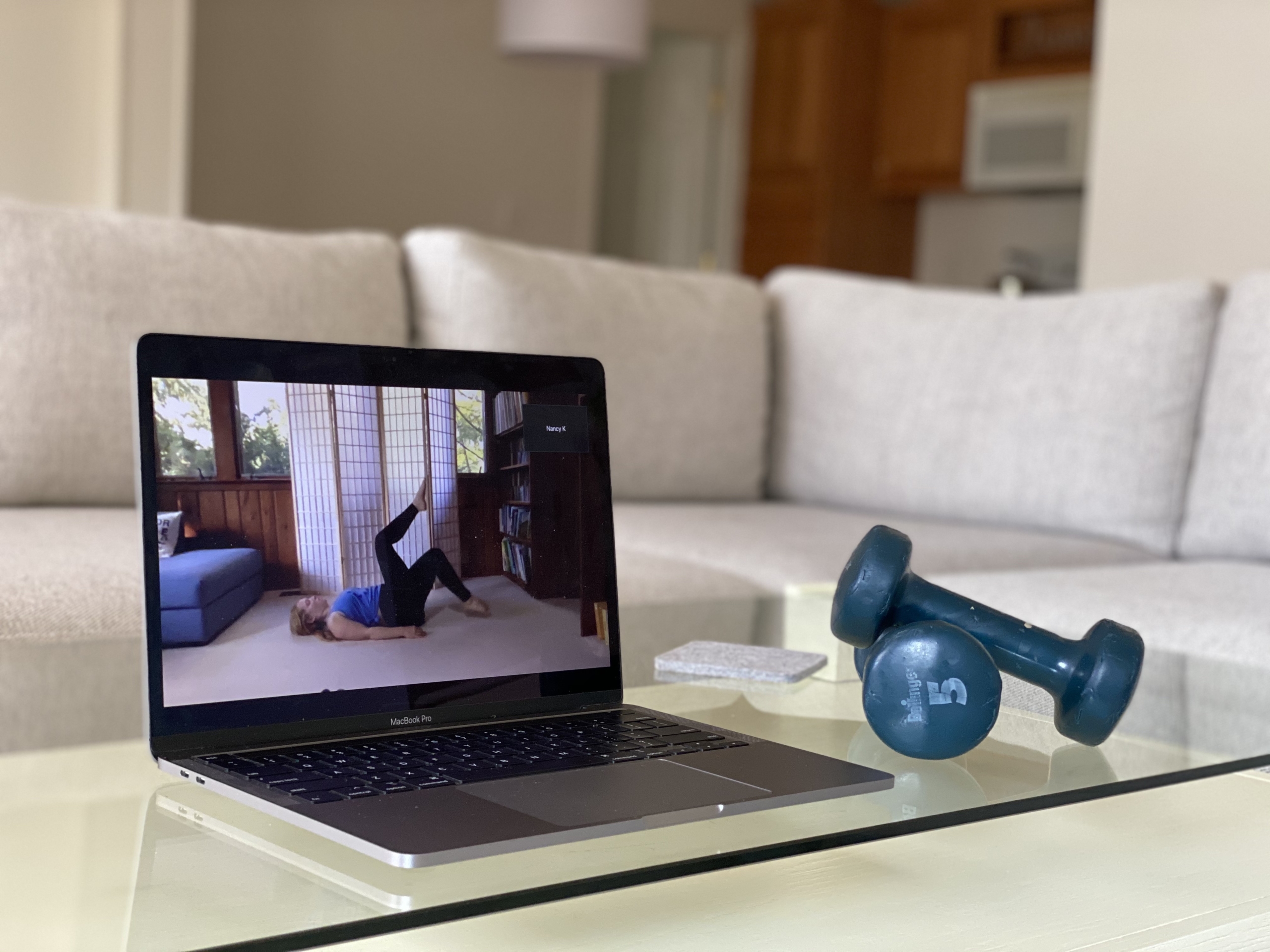
- Convenience and comfort of working out in your own home
Just rolling out of bed and feeling like taking a class in your pajamas? No problem. We’ve been there and done that, too. While our instructors love to see you moving, there’s no judgement on those days you turn your camera off and move with no one watching. Another perk of livestream classes is that there’s no commute to factor in. Join us on the fly when your 11:00 o’clock meeting gets cancelled. Don’t want to go out in the cold rain? Stay cozy in your very own living room.
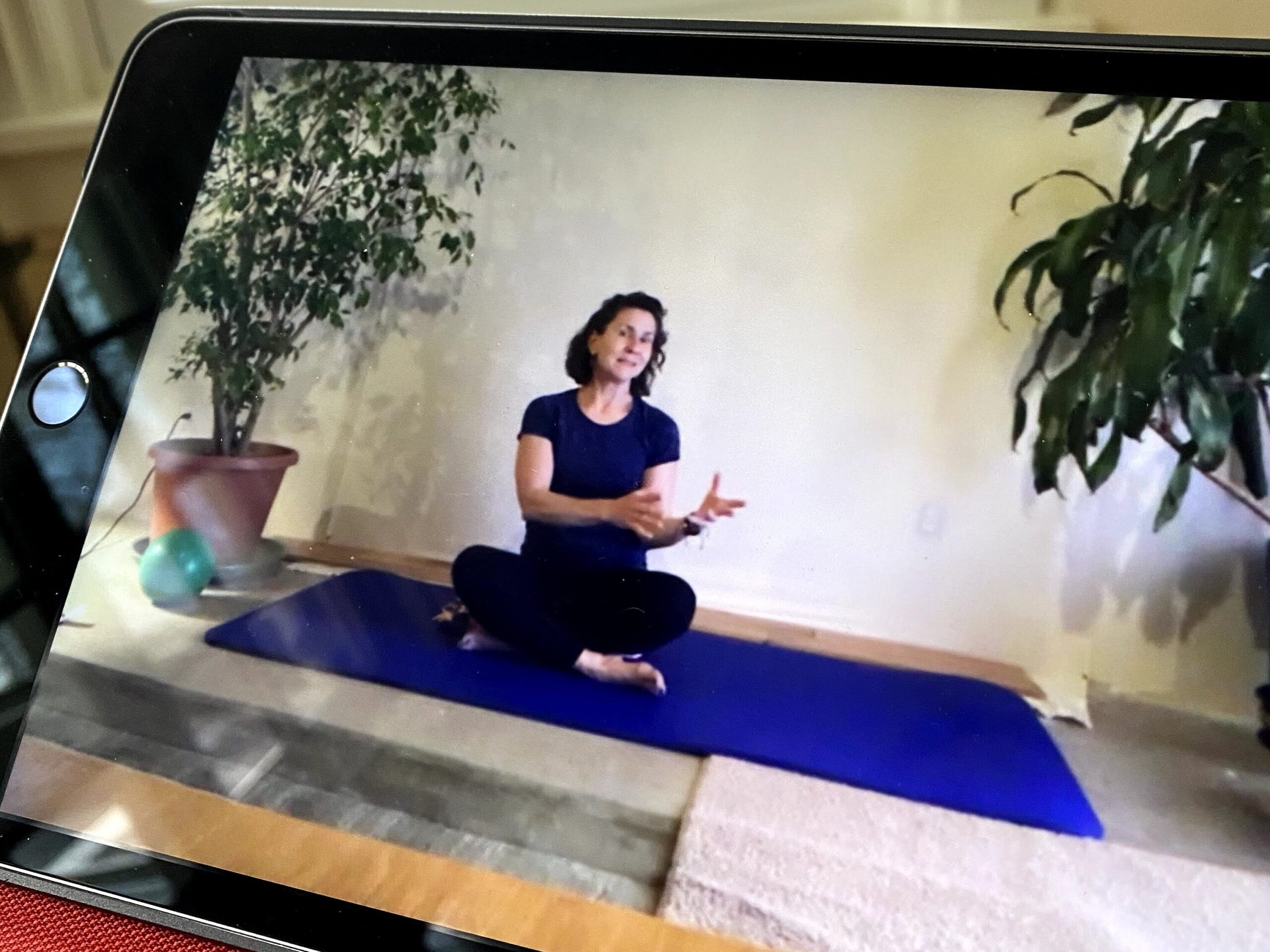
- Expert support you need to meet your personal goals
We may be connecting on Zoom, but there’s a whole team of experts behind the screen ready to answer your questions and make sure we’re meeting your needs. We’re always happy to recommend classes, talk through your goals and set a schedule for you, or answer questions about any specific issues or modifications you may need.

- Variety of fresh class content each session to stave off boredom
Did you love your class today? Awesome. Do you want to do that exact same class over and over again? Maybe not. (Ok, maybe once or twice.) With livestream classes, trainers are able to progress a group and move you through a repertoire week after week. We promise to keep you on your toes!
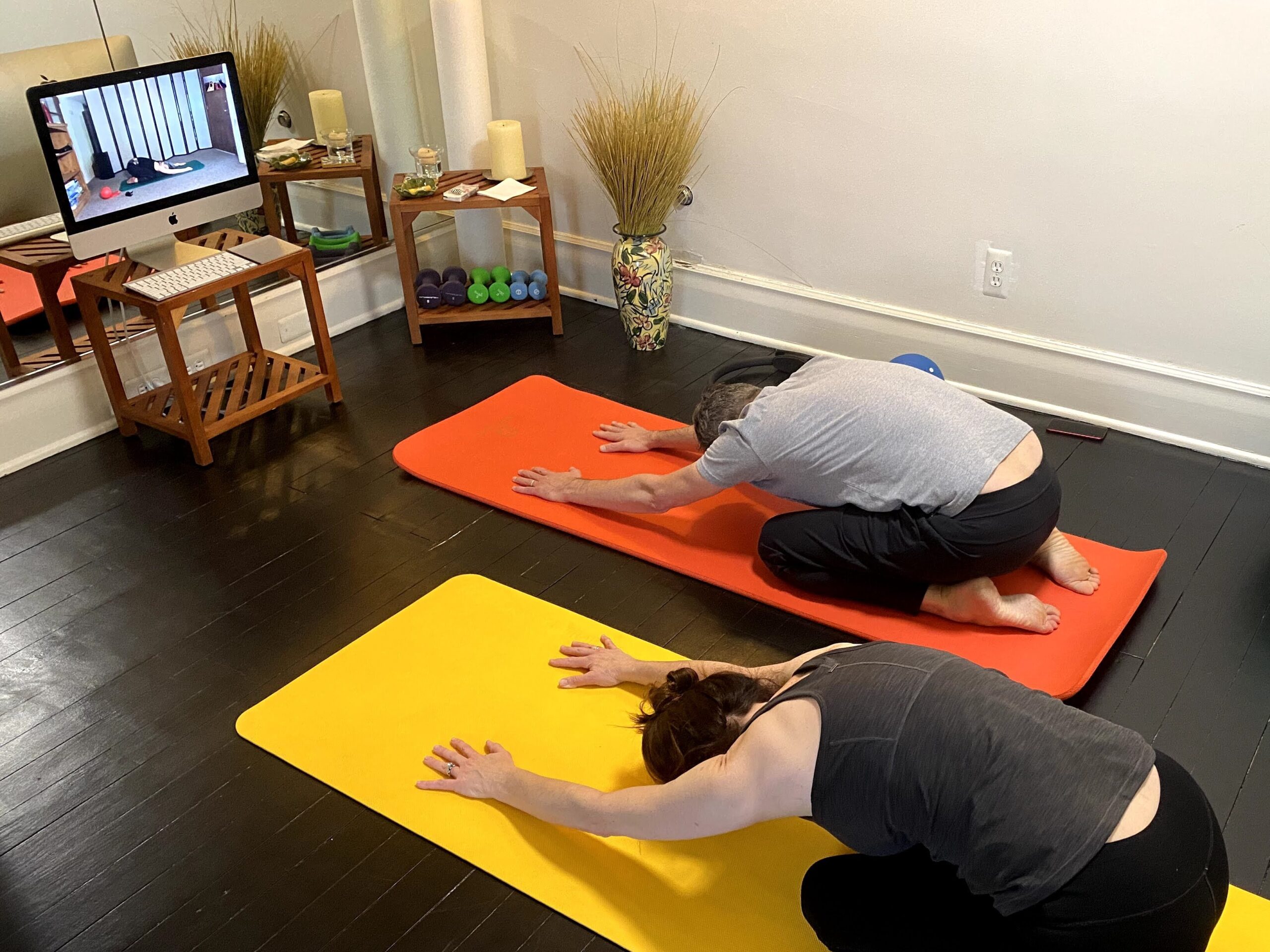
- Connection to a wellness-focused community of peers and professionals
We’ve all found our way to MOVE Wellness for a reason (or reasons). Our community is a group of people who seek to improve our well-being through movement, nutrition, education, and other holistic methods. We all find joy and comfort in traveling on this journey together. MOVE often hosts special community-focused events like our MOVE Book Club, unique-topic Member Workshops, MOVE Donation Classes for social justice, and more.
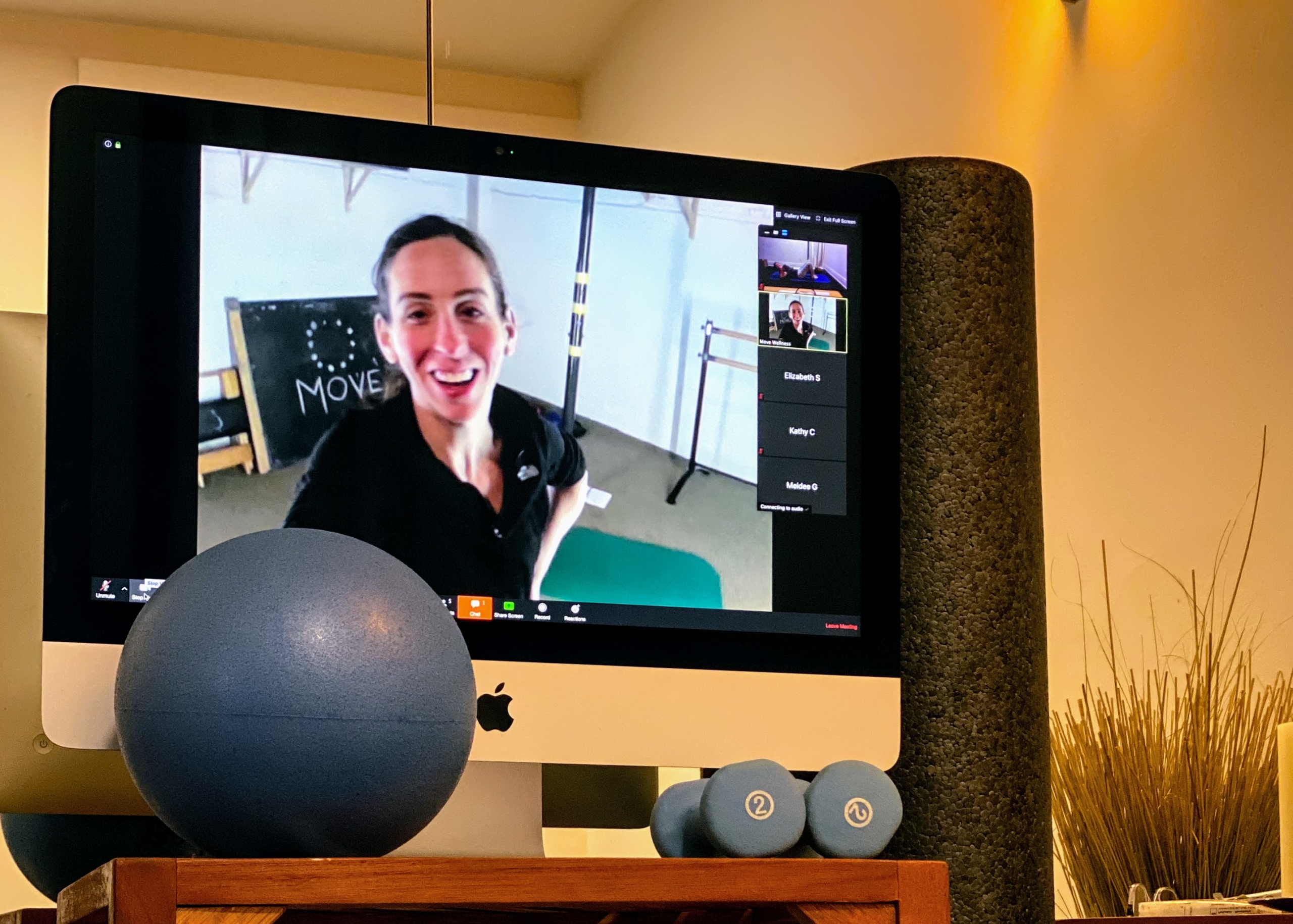
- Reliable access to our expert team to answer your questions
Trainers are available for a quick chat before or after class as well. Something specific going on with your body? Hop into class early or jump into the chat so that your trainer can be sure to throw out custom suggestions and modifications in class. Our concierge team is always standing by to answer any bigger questions and make sure you’re on your best journey.
Your Interactive Livestream Program Starts Here
Let our expert instructors come to you—attend your choice of 30+ professional studio classes from the comfort of your home. Start your free 14-day trial of MOVE Livestream classes today.
The ability to create a fit, vital body for a lifetime, safely and efficiently, is what makes Pilates unique among movement systems. It can be hard to find words to describe something as experiential as Pilates, so we’ve put together a series of short workshops to walk you through the essentials of this unique movement system. Join MOVE Co-Founder Elaine Economou as she explains the history of Pilates and takes you to the mat to feel what the movement entails. You’ll learn how to approach your own body in creating a movement routine or system for yourself. We’ll also share what to expect in a Pilates class so you can see what it will be like. Pilates will help you optimize your body for what you love to do in life.
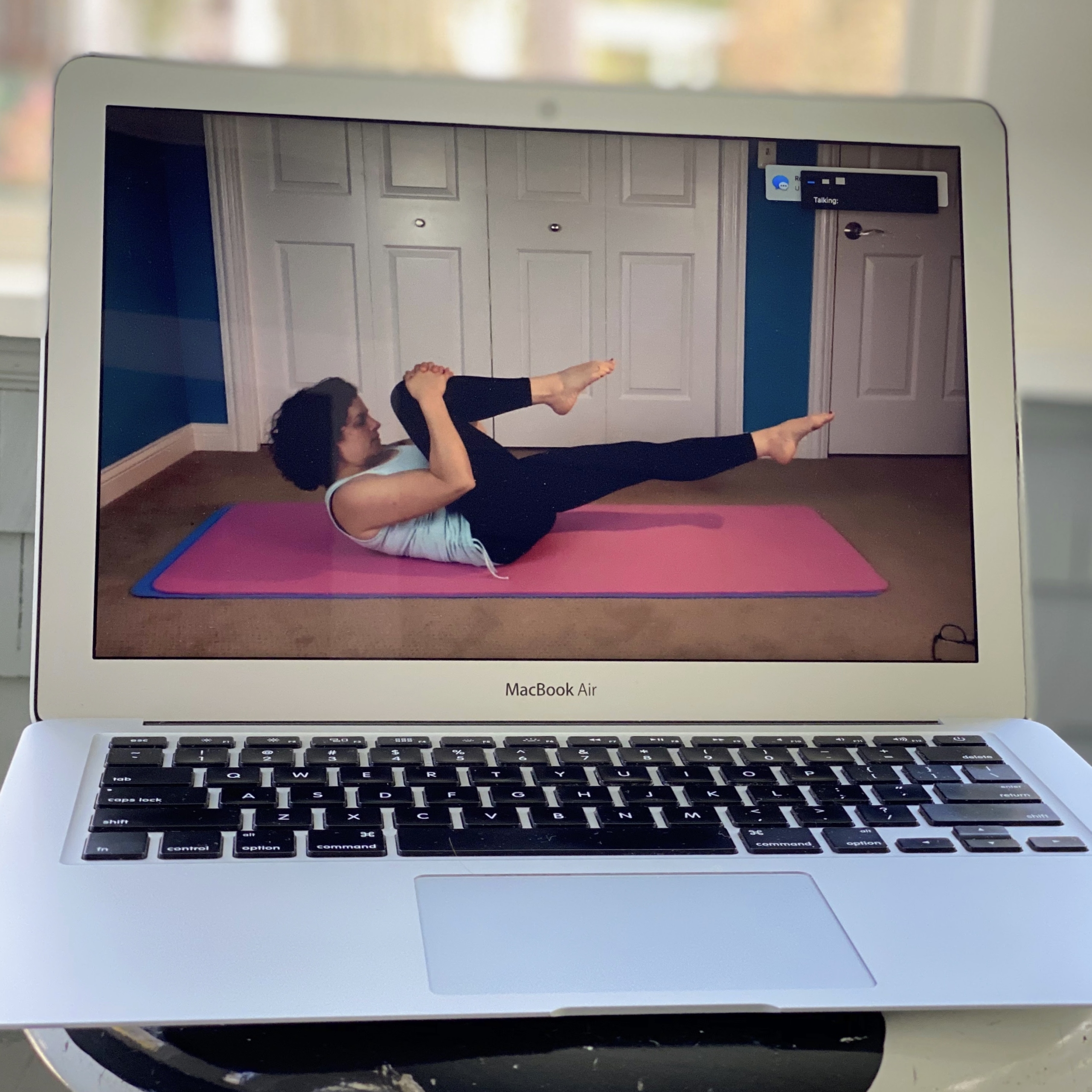
What is Pilates?
What is Pilates? Pilates is a unique, anatomy-based system designed by a forward-thinking visionary, Joseph Pilates. The goal of a Pilates session is to move through the repertoire of exercises at the level and pace that suits you, moving your spine in all planes of motion and challenging your body with different relationships to gravity. The original Pilates exercises focused simply on the body and breathwork. Over time, various props and specialized equipment became integrated into the movement system. Though challenging, the workout and exercises will energize and invigorate.
Pilates is not a staged Instagram photo of an actress or professional athlete training on some sort of mysterious equipment. Nor is it a painful group fitness class designed to tone your abs, but that instead leaves you with neck or low back pain. No, it’s not even “yoga for core strength.”
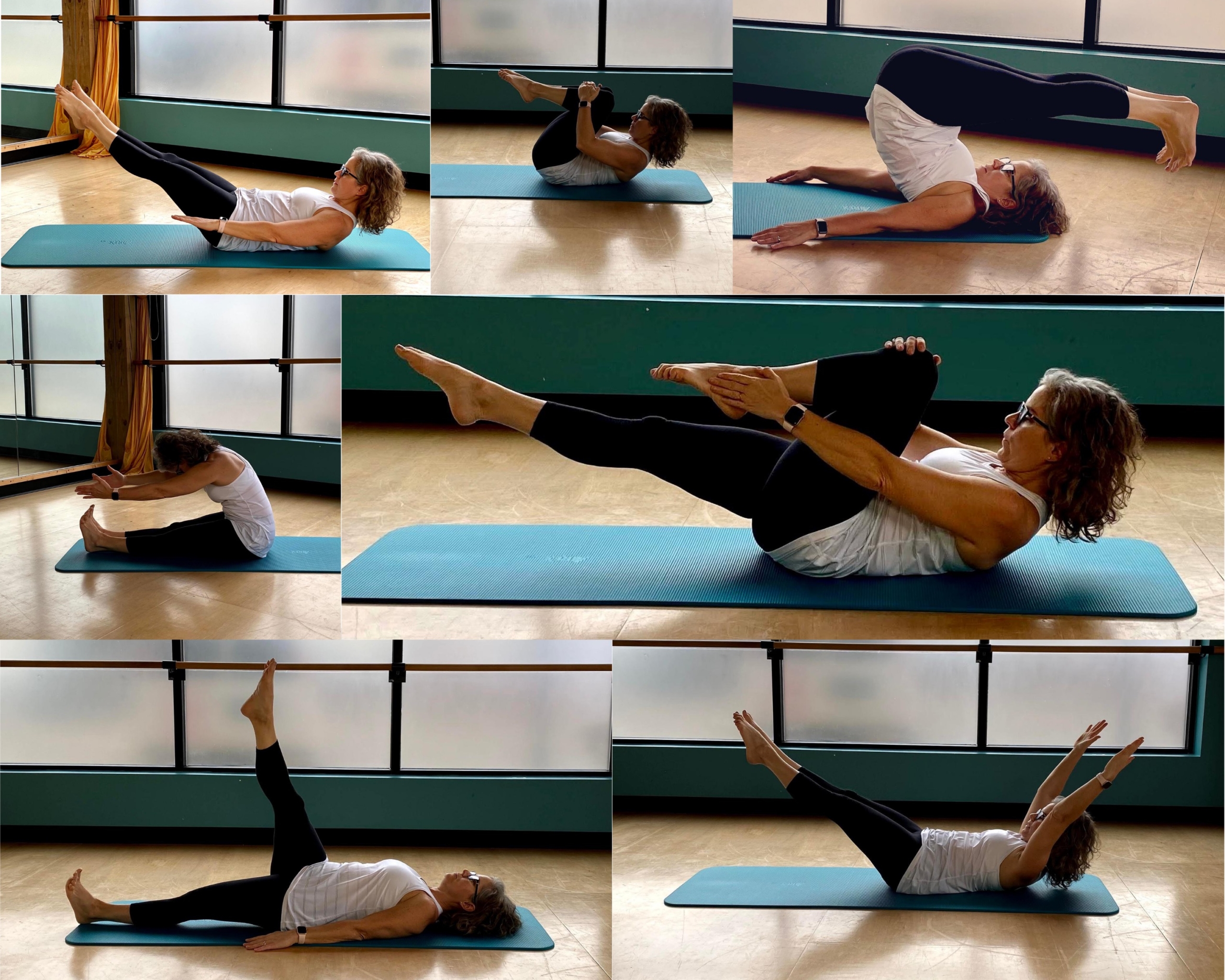
Let’s meet Joe: A brief history of Pilates
Before creating Pilates—or what he first called “Contrology”—Joseph Pilates was an avid student of movement. His work was developed 100 years ago from personal inquiry into his own health and physical fitness. He studied the movements of animals and statues of ancient humans with robust musculature. He was drawn to the Greek ideal of a human—a balance of mind, body, and spirit. This is the heart of Pilates: to let you build the best version of yourself. Pilates was infinitely curious about body and building strength. During World War I, he wound up in the UK in an internment camp. It is generally believed that was where he developed the movements that became his repertoire of Pilates mat exercises. Following the war, Pilates emigrated to the US where his work evolved into two things that form the foundation of the Pilates we know today.
1. A Repertoire of Exercises.
The wisdom of the original 34 Pilates mat exercises continue to reveal themselves. As our knowledge of the body evolves we can see the deep wisdom in how Pilates organized these original exercises. The exercises were to be done in a particular order and a particular way with few props to optimize the body’s movement at any age and physical ability level.
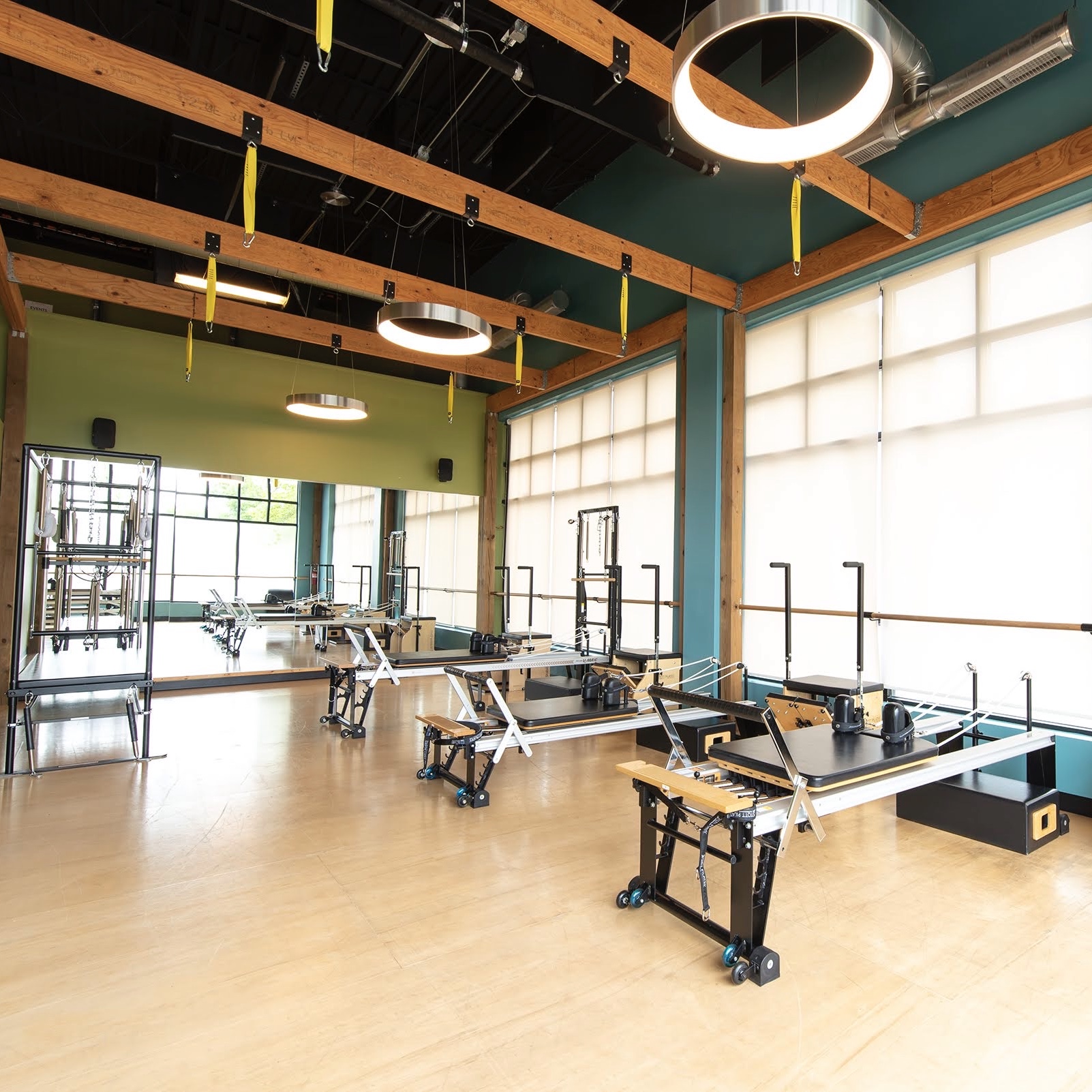
2. Equipment to Strengthen the Body.
While record-keeping from the war was spotty at best, it’s commonly believed that Pilates found the basis for his spring-based resistance equipment during the war when working with bedridden, injured soldiers by tying sheets onto the bed springs for resistance training. Regardless of his inspiration, today we benefit from his experiments by working on the Reformer, Cadillac, and Chair. This innovative equipment offers us a multitude of ways to personalize the exercises and meet individual needs.
Benefit of Pilates
We already know the benefits of Pilates are vast. There is mounting research that Pilates supports a number of pathologies, postural issues, and is an effective strengthening modality for bodies at any age and stage. Some of the physical benefits of a Pilates practice include:
- Strength
- Stability
- Flexibility
- Mobility
- Balance
The principles that Joseph Pilates developed have held true. There is deep truth in how we organize and use our bodies and Pilates is a system that is efficient, effective, and safe. The principles can be applied to every human body at every age and stage of life.
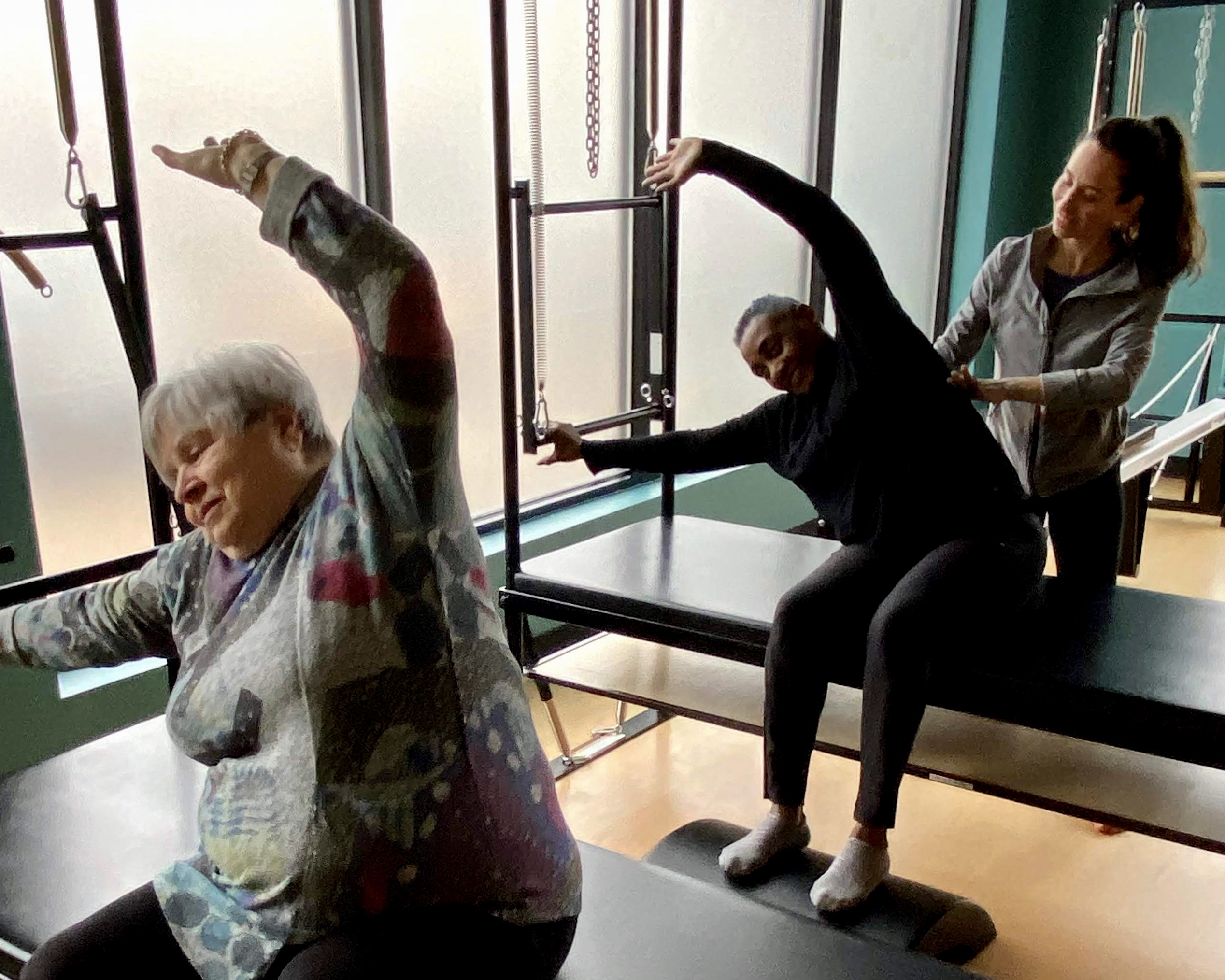
Pilates can be done in its most basic form gently and simply. As ability, strength, and coordination increase, we can add complexity and more challenging exercises. Anyone who wants increased core and overall strength, fewer injuries, better coordination, and better muscle function can and should do Pilates. When you practice these exercises regularly, you can take them to other parts of your life, including your other fitness routines, hobbies you love, and the activities of life. Pilates will bring ease, strength, and balance into your body.
“If your spine is inflexibly stiff at 30 you are old. If it is completely flexible at 60 you are young.”
—Joseph Pilates
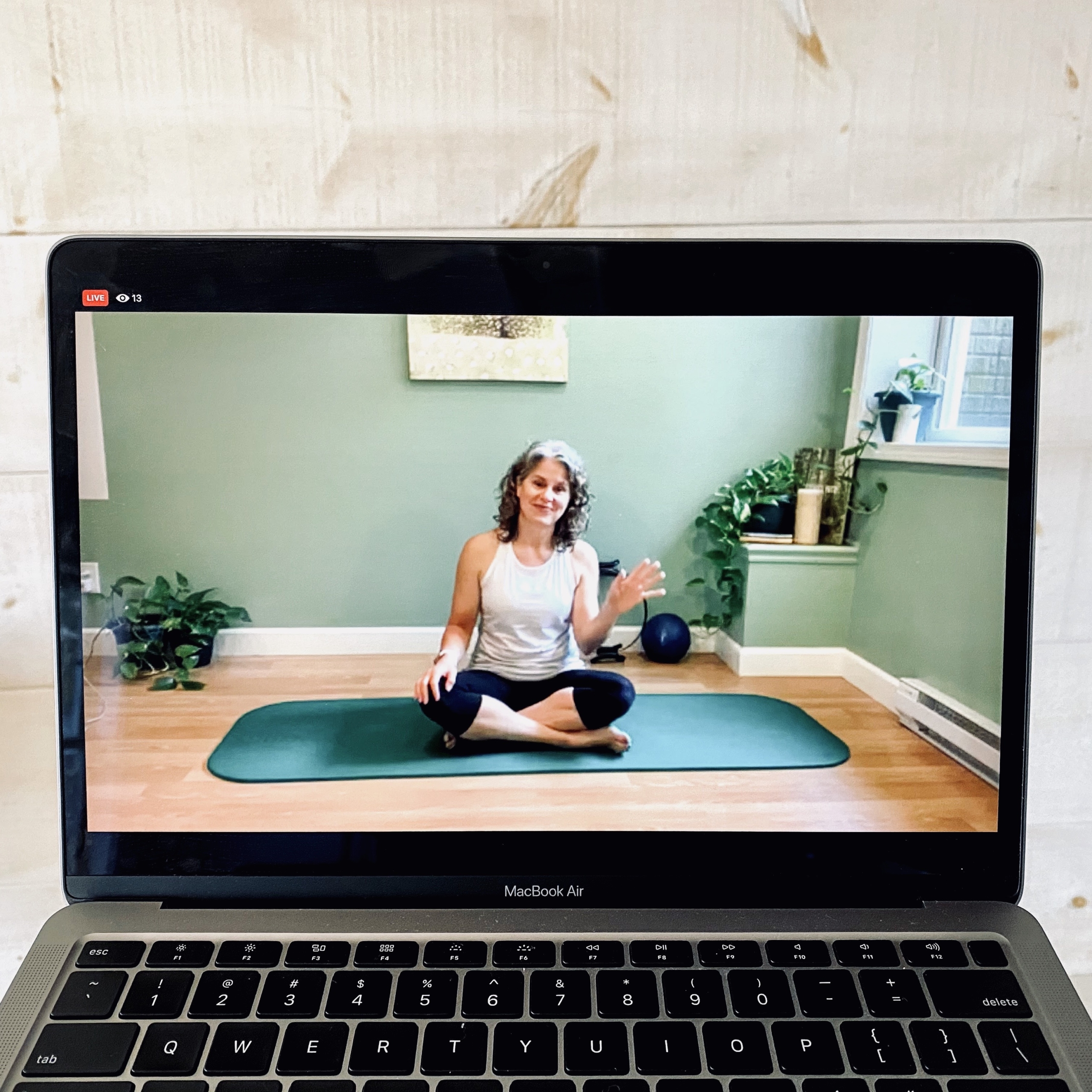
The Basics: A 4-Part Pilates Series to Get Started
As you prepare to build a Pilates movement system for yourself, it’s important to start at the beginning to build the vocabulary and understand the concepts. As you feel them in your own body you will start to connect to the organization of the movements. Advanced athletes may be able to jump into an advanced class and be able to do the movements, but without the basics their benefits will be limited by a lack of understanding. With a goal to build strength, ease, and mobility in our bodies, Elaine has laid out the foundation of the system in 4 parts: Breathing, Abdominals, Spinal Mobility, and Strength.
Pilates Basics Part 1: Breathing
Pilates is a mindful movement practice with guided breathing principles. Joseph Pilates is known for saying that “…above all, learn how to breathe correctly.” Connecting our breath with movement is foundational to organizing the musculoskeletal system and can help us improve circulation, reduce stress, improve concentration, and support a balanced nervous system. These help us move through the day with ease.
Pilates Basics Part 2: Abdominals
In Part 1, we learned how breathing connects to our movement, particularly our abdominal connection. Now we will challenge and strengthen this connection to support the trunk against the movement of the legs for a healthy back. These layers of exercise will challenge your stability and mobility and can then be applied to anything you love to do, with the goal of feeling energized in our day.
Pilates Basics Part 3: Spinal Mobility
Part 3 of our Pilates series will show us how we use the breath and the abdominal connection to support moving the spine in all directions. In Pilates, we connect our breathing to movement in class so out in the world our bodies feel strong and supported without a lot of formal effort. We’re practicing for the activities of daily life.
Pilates Basics Part 4: Strength
It’s time to layer the principles of Pilates as we create an embodied strength and understanding of our own unique structure and function. Pilates will build strength through the center of the body—commonly referred to as our core—and into the periphery, developing strong arms and legs. This moves your body in a way that can build real strength for you to do the work of life.
What to Expect in A Pilates Class
Now that you’ve experienced the foundation of Pilates, let’s get you ready to join us in a regular class! At MOVE, we level our classes as Gentle/Intro, Level 1, Level 2, Level 3, and Advanced. Our movement experts and concierge service will connect you with the class that’s right for you. We generally suggest our clients start with a Gentle or Level 1 class until they feel secure in the basics and pace of movement. Even our elite athletes start with Level 1 to learn the basics! This foundation will help you feel the depth of this movement system and get the most out of our classes.
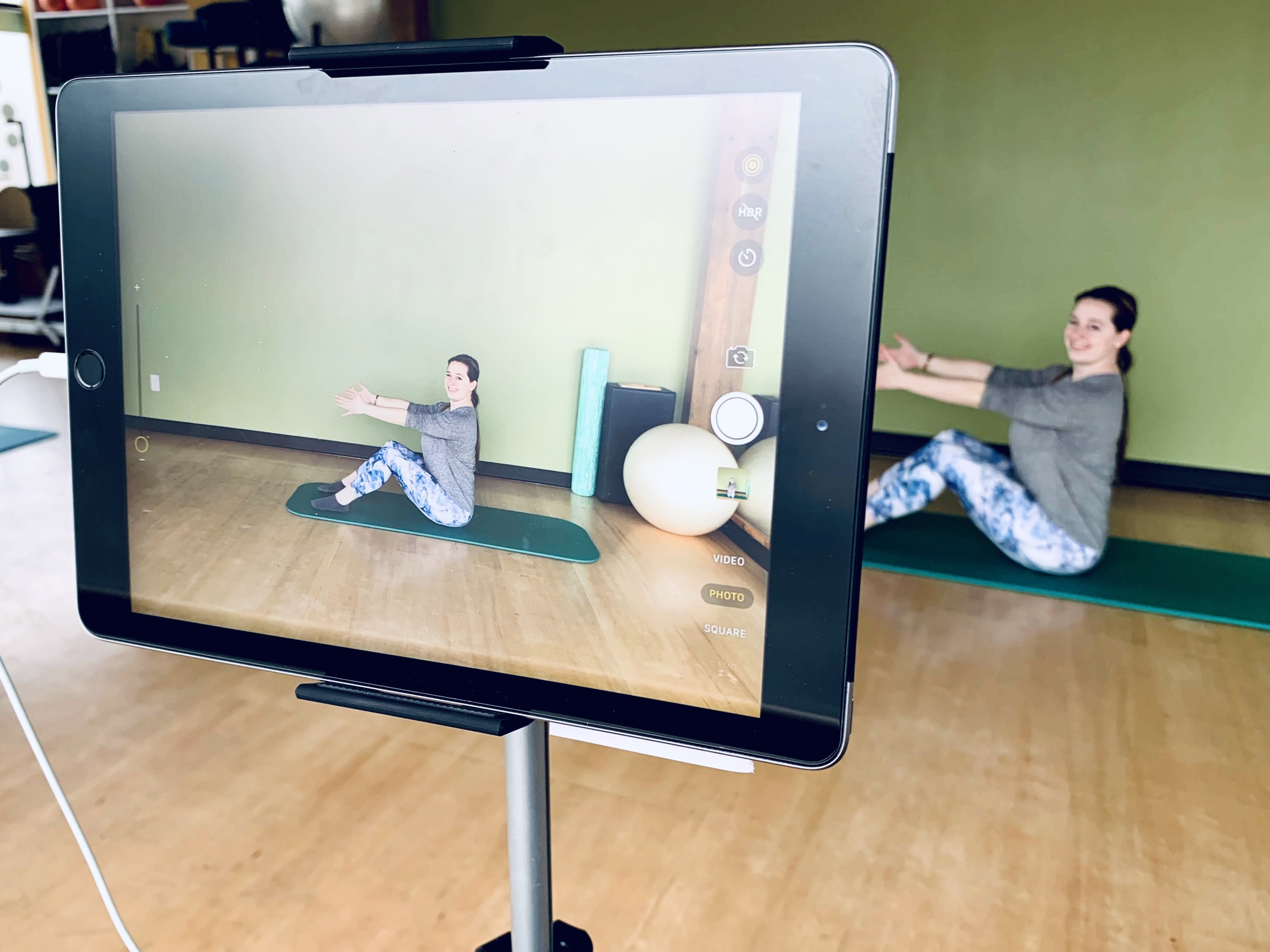
Some concepts you will generally explore in a Pilates class.
- Breathing. It’s so important to connect to muscular activation of tissues. We inhale to fill the lungs completely and expand the diaphragm to help the transverse abdominis and pelvic floor muscles expand, and exhale completely for an efficient exchange of oxygen. We’re building the interoceptive sense and understanding the sensation of what’s happening in the body. Breathing optimally brings tone to the deep support structures of the trunk.
- Breathing and moving. How we combine breathing and movement depends on the level of the class, age and stage of life, desired outcomes of the teacher, equipment used, and whether the class is based on the classic exercises or creative interpretation. All Pilates classes have a theme or goal that the teacher is supporting.
- Mobilizing your spine in all planes of motion. Pilates will bring you through rotation or flexion, extension, and lateral flexion. We’ll bring ease and movement to all the joints of the spine in all planes of motion. Working on a mat, you’ll organize your abdominals to stabilize the pelvis against the movement of the legs. Bringing ease of movement to the pelvis will bring balance of movement into the spine. It’s all connected!
- Challenging your body with all relationships to gravity. You’ll move on your back, belly, all-fours, seated, plank, standing, and using increasingly longer levers to challenge yourself. Class will flow through all of those positions. As we stabilize the pelvis against movement of the legs, our core will support us. Think of the body as a system. We will target the whole system to move optimally, not just one muscle.
- Work at the level right for you. All of this work will be done within the level that’s right for your body, and your age and stage of life. Pilates offers something for everyone and every body. We will optimize your body for what you love to do in life and bring ease and balance to support you. It’s about more than being defined by just musculature—it’s thinking about fitness as resilience.

Join the MOVE Wellness® Community!
You CAN start now. Here are 3 ways you can join the MOVE Wellness community today.
- Private Sessions: Virtual or in-studio instruction, customized to your body and your needs.
- Livestream Classes: Read our Livestream FAQs for more information. Drop-in or unlimited class memberships are available. Choose from Pilates, GYROKINESIS®, Barre, Yoga, and more. Additional options to enhance your movement routine are coming this fall, so stay tuned.
- MOVE YouTube Channel: Always open to explore at your convenience, these videos are available to anyone. Exciting new content is added regularly. Choose one video or mix and match your own workout.
“In 10 sessions you’ll feel the difference, in 20 sessions you’ll see the difference, and in 30 sessions you’ll have a whole new body”.
—Joseph PIlates
You CAN start now.
Still have questions? Give us a call at 734-224-2560 or email office@movewellness.com. Let us get you started on your personal Pilates journey today!
